Emerging Trends in Thermo-Optic and Electro-Optic Materials for Tunable Photonic Devices
Abstract
1. Introduction
2. Fundamentals of TO and EO Effects
2.1. TO Effect in Photonic Tuning
2.2. EO Effect in Photonic Tuning
3. Key Materials for TO Applications
| Material | Key Characteristics | Typical Wavelength Range | Advantages | Challenges |
|---|---|---|---|---|
| Silicon [60] | High TOC, widely used in integrated photonics, CMOS-compatible | 1200 nm to 1700 nm (NIR) | Well-established fabrication process, cost-effective, easy integration with existing semiconductor tech | Low TOC compared to other materials (polymers or chalcogenides), sensitivity to temperature fluctuations, and a limited wavelength range |
| Silicon nitride [89] | High thermal stability, low loss in the visible to near-infrared range, relatively high TOC | 400 nm to 1600 nm (VIS-NIR) | Low-loss, high-performance for visible and near-infrared, compatible with standard photonic integration | Higher fabrication complexity, less widely used in industry compared to Si |
| Lithium niobate [81] | High EO and TOCs, high-index contrast | 600 nm to 1600 nm | Strong TO effect, suitable for high-performance photonic devices, widely used for modulators | Expensive, difficult to integrate with Si, handling issues due to fragility |
| Silicon carbide (SiC) [90] | High thermal conductivity, wide bandgap, stable at high temperatures | 800 nm to 2000 nm | Extremely high thermal stability, works well in harsh environments, good for high-power applications | Expensive, difficult to process and integrate with other materials, and not widely used in photonics |
| Polymer-based materials (e.g., PMMA, SU-8) [61] | Moderate TOCs, flexible, lower refractive index contrast | 400 nm to 1550 nm | Cost-effective, flexible, easy to process, adaptable for low-loss devices, and integration with flexible substrates | Lower TOCs compared to inorganic materials, lower stability under temperature cycling |
| Gallium arsenide (GaAs) [91] | High TOC, widely used in optoelectronics | 800 nm to 1700 nm | High performance in photonic devices, used for high-speed communications and optical switching | Difficult to integrate with Si, expensive, challenging to scale for large-scale photonic circuits |
| Chalcogenide glasses [62,92] | High refractive index, large TOCs, used in infrared photonics | 1000 nm to 5000 nm (NIR-MIR) | Excellent performance in the infrared range, suitable for nonlinear optics and low-loss waveguides | Not CMOS-compatible, expensive, and difficult to manufacture on a large scale |
| Silica [93] | Very low TOC, wide transparency window, excellent optical quality | 400 nm to 2500 nm | Low optical loss, highly CMOS-compatible, mature fabrication processes | Not actively tunable, poor thermal and electro-optic tuning, low refractive index contrast |
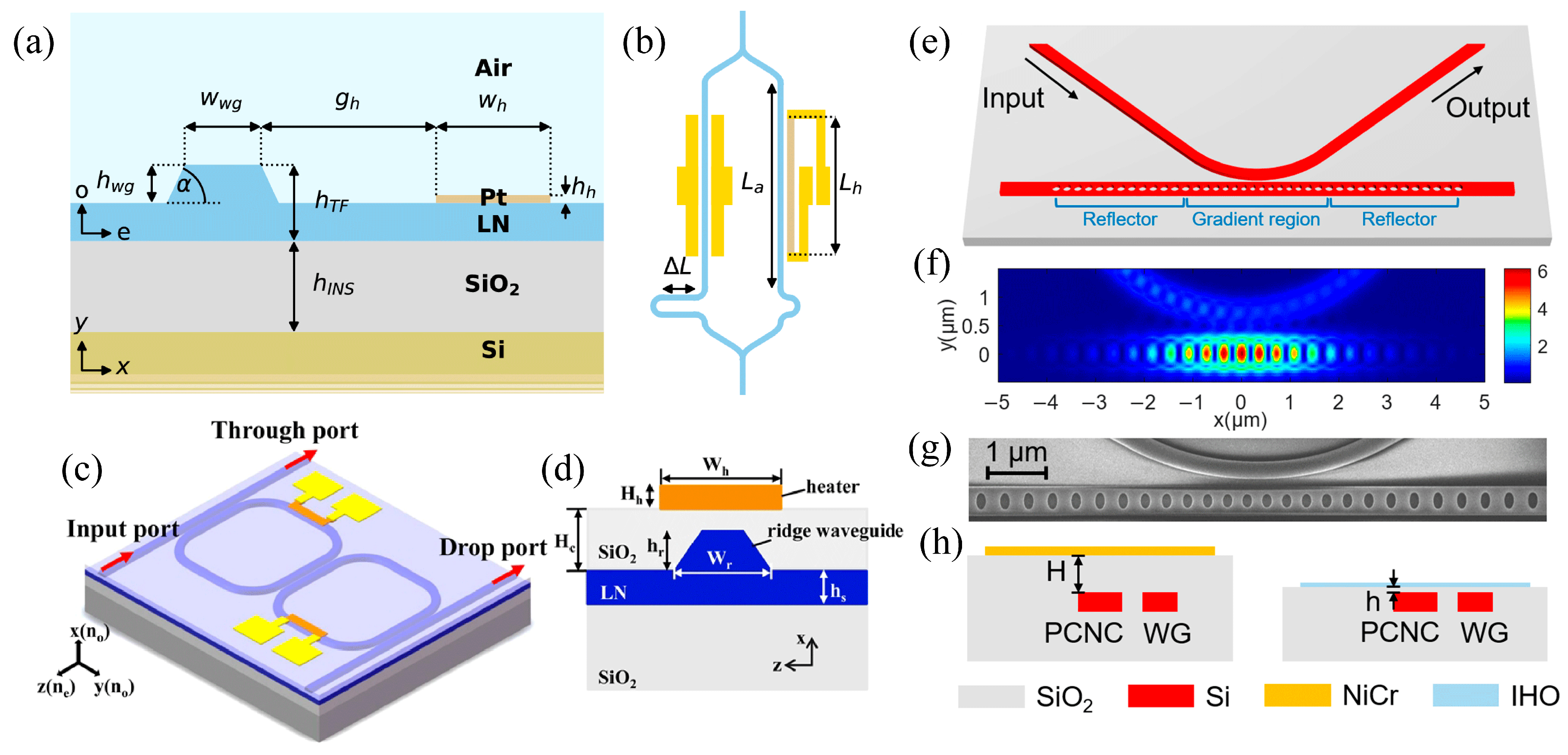
4. Key Material Classes for EO Applications
| Material | Key Characteristics | Typical Wavelength Range | Advantages | Challenges |
|---|---|---|---|---|
| Lithium niobate [107,108] | Benchmark EO material: advances in thin-film and LNOI platforms | 420 nm to 5200 nm | High EO efficiency; wide transparency window (0.4–5.5 µm); mature fabrication techniques | CMOS integration is challenging due to material incompatibility [25] |
| EO polymers [109] | High-speed modulation potential; organic materials with tunable properties | 1310 nm to 1650 nm | Ultrafast response; potential for flexible integration | Stability issues under high temperatures; integration challenges with CMOS processes [101] |
| Barium titanate and Perovskites [110] | High EOCs (e.g., r42 ≈ 923 pm/V); emerging perovskite materials | 500 nm to 1600 nm | Strong modulation performance; compatibility with CMOS platforms [110] | Material stability and uniform deposition remain a challenge |
| III–V Semiconductors (GaAs, InP) [111] | Active modulation with integrated electronics; wavelength-dependent performance | 850 nm to 1650 nm | Direct bandgap materials enable efficient light emission; integration of active components like lasers and detectors | Limited CMOS compatibility; performance varies with wavelength [109] |
| Lead zirconate titanate [104,105] | Ferroelectric ceramic with high EOC (r33 up to ~400 pm/V); piezoelectric properties | 1310 nm to 1650 nm | High EO efficiency; can be integrated as thin films on silicon; dual EO and piezoelectric functionality | Optical losses at telecom wavelengths; deposition and poling uniformity challenges |
5. Device Architecture and Integration Platforms
5.1. Waveguides, Modulators, Switches, and Tunable Filters
5.2. Bulk vs. Thin-Film Integration
5.3. Heterogeneous Integration and Hybrid Material Systems
5.4. Role of Plasmonics and MS in Enhancing Effects
6. Performance Metrics and Comparison
6.1. Tuning Efficiency
6.2. Insertion Loss, Bandwidth, and Speed
6.3. Power Consumption
6.4. Long-Term Stability and Fatigue
7. Emerging Trends and Future Directions
8. Conclusions
Funding
Institutional Review Board Statement
Informed Consent Statement
Data Availability Statement
Acknowledgments
Conflicts of Interest
Abbreviations
References
- Chrostowski, L.; Grist, S.; Flueckiger, J.; Shi, W.; Wang, X.; Ouellet, E.; Yun, H.; Webb, M.; Nie, B.; Liang, Z.; et al. Silicon Photonic Resonator Sensors and Devices. In Proceedings of the Laser Resonators, Microresonators, and Beam Control XIV, San Francisco, CA, USA, 6 February 2012; SPIE: Bellingham, WA, USA, 2012; Volume 8236, pp. 387–402. [Google Scholar]
- Altug, H.; Oh, S.-H.; Maier, S.A.; Homola, J. Advances and Applications of Nanophotonic Biosensors. Nat. Nanotechnol. 2022, 17, 5–16. [Google Scholar] [CrossRef] [PubMed]
- Cao, Z.; He, J.-J.; Guo, Y.; Li, M. Optical Ring Resonator Biosensor for Small Molecule Detection. In Proceedings of the Asia Communications and Photonics Conference (2017), Guangzhou, China, 10–13 November 2017; Optica Publishing Group: Washington, DC, USA, 2017; p. S4I.5. [Google Scholar]
- Butt, M.A. A Comprehensive Exploration of Contemporary Photonic Devices in Space Exploration: A Review. Photonics 2024, 11, 873. [Google Scholar] [CrossRef]
- Ko, J.H.; Yoo, Y.J.; Lee, Y.; Jeong, H.-H.; Song, Y.M. A Review of Tunable Photonics: Optically Active Materials and Applications from Visible to Terahertz. iScience 2022, 25, 104727. [Google Scholar] [CrossRef] [PubMed]
- Woska, S.; Münchinger, A.; Beutel, D.; Blasco, E.; Hessenauer, J.; Karayel, O.; Rietz, P.; Pfleging, S.; Oberle, R.; Rockstuhl, C.; et al. Tunable Photonic Devices by 3D Laser Printing of Liquid Crystal Elastomers. Opt. Mater. Express 2020, 10, 2928–2943. [Google Scholar] [CrossRef]
- Afridi, A.; Gieseler, J.; Meyer, N.; Quidant, R. Ultrathin Tunable Optomechanical Metalens. Nano Lett. 2023, 23, 2496–2501. [Google Scholar] [CrossRef]
- Effah, E.; Nettey-Oppong, E.E.; Ali, A.; Byun, K.M.; Choi, S.H. Tunable Metasurfaces Based on Mechanically Deformable Polymeric Substrates. Photonics 2023, 10, 119. [Google Scholar] [CrossRef]
- Arbabi, E.; Arbabi, A.; Kamali, S.M.; Horie, Y.; Faraji-Dana, M.; Faraon, A. MEMS-Tunable Dielectric Metasurface Lens. Nat. Commun. 2018, 9, 812. [Google Scholar] [CrossRef]
- Bai, W.; Yang, P.; Huang, J.; Chen, D.; Zhang, J.; Zhang, Z.; Yang, J.; Xu, B. Near-Infrared Tunable Metalens Based on Phase Change Material Ge2Sb2Te5. Sci. Rep. 2019, 9, 5368. [Google Scholar] [CrossRef]
- Shalaginov, M.Y.; An, S.; Zhang, Y.; Yang, F.; Su, P.; Liberman, V.; Chou, J.B.; Roberts, C.M.; Kang, M.; Rios, C.; et al. Reconfigurable All-Dielectric Metalens with Diffraction-Limited Performance. Nat. Commun. 2021, 12, 1225. [Google Scholar] [CrossRef]
- Ghaffari, V.; Yousefi, L. Integrated Optical Beam Steering Device Using Switchable Nanoantennas and a Reflective Metalens. Sci. Rep. 2023, 13, 7099. [Google Scholar] [CrossRef]
- Guarino, A.; Poberaj, G.; Rezzonico, D.; Degl’Innocenti, R.; Günter, P. Electro–Optically Tunable Microring Resonators in Lithium Niobate. Nat. Photon. 2007, 1, 407–410. [Google Scholar] [CrossRef]
- Qin, J.; Xia, S.; Yang, W.; Wang, H.; Yan, W.; Yang, Y.; Wei, Z.; Liu, W.; Luo, Y.; Deng, L.; et al. Nanophotonic Devices Based on Magneto-Optical Materials: Recent Developments and Applications. Nanophotonics 2022, 11, 2639–2659. [Google Scholar] [CrossRef] [PubMed]
- Gabbani, A.; Sangregorio, C.; Tandon, B.; Nag, A.; Gurioli, M.; Pineider, F. Magnetoplasmonics beyond Metals: Ultrahigh Sensing Performance in Transparent Conductive Oxide Nanocrystals. Nano Lett. 2022, 22, 9036–9044. [Google Scholar] [CrossRef]
- Kumari, S. A Comprehensive Study of Magneto-Optic Materials and Its Applications. Mater. Today Proc. 2022, 56, 100–106. [Google Scholar] [CrossRef]
- Ceccarelli, F.; Rakonjac, J.V.; Grandi, S.; de Riedmatten, H.; Osellame, R.; Corrielli, G. Integrated Thermo-Optic Phase Shifters for Laser-Written Photonic Circuits Operating at Cryogenic Temperatures. J. Phys. Photonics 2024, 6, 045023. [Google Scholar] [CrossRef]
- Iyer, P.P.; DeCrescent, R.A.; Lewi, T.; Antonellis, N.; Schuller, J.A. Uniform Thermo-Optic Tunability of Dielectric Metalenses. Phys. Rev. Appl. 2018, 10, 044029. [Google Scholar] [CrossRef]
- Juan-Colás, J.; Johnson, S.; Krauss, T.F. Dual-Mode Electro-Optical Techniques for Biosensing Applications: A Review. Sensors 2017, 17, 2047. [Google Scholar] [CrossRef]
- Wu, K.; Wang, Y.; Qiu, C.; Chen, J. Thermo-Optic All-Optical Devices Based on Two-Dimensional Materials. Photon. Res. 2018, 6, C22–C28. [Google Scholar] [CrossRef]
- Karimi, Y.; Kaatuzian, H. Low-Power Fano Resonance-Based MIM Plasmonic Switch Using Kerr-Type Nonlinear Material. In Proceedings of the 2021 29th Iranian Conference on Electrical Engineering (ICEE), Tehran, Iran, 18–20 May 2021; pp. 32–35. [Google Scholar]
- Li, M.; Tang, H.X. Strong Pockels Materials. Nat. Mater 2019, 18, 9–11. [Google Scholar] [CrossRef]
- Yadav, A.; Kumar, A.; Prakash, A. Design and Analysis of Optical Switches Using Electro-Optic Effect Based Mach-Zehnder Interferometer Structures. Mater. Today Proc. 2022, 56, 462–467. [Google Scholar] [CrossRef]
- Sun, D. A Proposal for Digital Electro-Optic Switches with Free-Carrier Dispersion Effect and Goos-Hanchen Shift in Silicon-on-Insulator Waveguide Corner Mirror. J. Appl. Phys. 2013, 114, 104502. [Google Scholar] [CrossRef]
- Li, M.; Ling, J.; He, Y.; Javid, U.A.; Xue, S.; Lin, Q. Lithium Niobate Photonic-Crystal Electro-Optic Modulator. Nat. Commun. 2020, 11, 4123. [Google Scholar] [CrossRef] [PubMed]
- Aisheh, M.A.; Kalliyadan, A.C.; Abutoama, M.; Abuleil, M.J.; Abdulhalim, I. Deep Gratings Filled with Liquid Crystal as Tunable Photonic Metamaterial. In Proceedings of the Liquid Crystals Optics and Photonic Devices, Strasbourg, France, 18 June 2024; SPIE: Bellingham, WA, USA, 2024; Volume 13016, p. 1301602. [Google Scholar]
- Bennet, M.; Gur, D.; Yoon, J.; Park, Y.; Faivre, D. A Bacteria-Based Remotely Tunable Photonic Device. Adv. Opt. Mater. 2017, 5, 1600617. [Google Scholar] [CrossRef]
- Muñoz-Hernández, T.; Reyes-Vera, E.; Torres, P. Tunable Whispering Gallery Mode Photonic Device Based on Microstructured Optical Fiber with Internal Electrodes. Sci. Rep. 2019, 9, 12083. [Google Scholar] [CrossRef]
- Wu, Q.; Zhang, H.; Jia, D.; Liu, T. Recent Development of Tunable Optical Devices Based on Liquid. Molecules 2022, 27, 8025. [Google Scholar] [CrossRef]
- Asquini, R.; d’Alessandro, A. Tunable Photonic Devices Based on Liquid Crystals and Composites. In Proceedings of the Liquid Crystals XVII, San Diego, CA, USA, 12 September 2013; SPIE: Bellingham, WA, USA, 2013; Volume 8828, pp. 108–121. [Google Scholar]
- Palik, E.D. (Ed.) Chapter 3—Thermo-Optic Coefficients. In Handbook of Optical Constants of Solids; Academic Press: Burlington, VT, USA, 1997; pp. 115–261. ISBN 978-0-12-544415-6. [Google Scholar]
- Hu, J.; Wu, J.; Liu, W.; Jin, D.; Dirani, H.E.; Kerdiles, S.; Sciancalepore, C.; Demongodin, P.; Grillet, C.; Monat, C.; et al. 2D Graphene Oxide: A Versatile Thermo-Optic Material. Adv. Funct. Mater. 2024, 34, 2406799. [Google Scholar] [CrossRef]
- Xie, Y.; Chen, L.; Li, H.; Yi, Y. Polymer and Hybrid Optical Devices Manipulated by the Thermo-Optic Effect. Polymers 2023, 15, 3721. [Google Scholar] [CrossRef]
- Allen, S. Electro-Optic Materials and Applications. In Electronic Materials: From Silicon to Organics; Miller, L.S., Mullin, J.B., Eds.; Springer USA: Boston, MA, USA, 1991; pp. 301–313. ISBN 978-1-4615-3818-9. [Google Scholar]
- Feng, S.; Wu, S.; Zhang, W.; Liu, F.; Wang, J. Organic Electro-Optic Materials with High Electro-Optic Coefficients and Strong Stability. Molecules 2024, 29, 3188. [Google Scholar] [CrossRef]
- Dushaq, G.; Serunjogi, S.; Tamalampudi, S.R.; Rasras, M. Electro-Optic Tuning in Composite Silicon Photonics Based on Ferroionic 2D Materials. Light. Sci. Appl. 2024, 13, 92. [Google Scholar] [CrossRef]
- Zhu, M.; Zhang, H.; Du, Z.; Liu, C. Structural Insight into the Optical and Electro-Optic Properties of Lead Zirconate Titanate for High-Performance Photonic Devices. Ceram. Int. 2019, 45, 22324–22330. [Google Scholar] [CrossRef]
- Chu, T.; Yamada, H.; Ishida, S.; Arakawa, Y. Compact 1 × N Thermo-Optic Switches Based on Silicon Photonic Wire Waveguides. Opt. Express 2005, 13, 10109–10114. [Google Scholar] [CrossRef] [PubMed]
- Butt, M.A. High Sensitivity Design for Silicon-On-Insulator-Based Asymmetric Loop-Terminated Mach-Zehnder Interferometer. Materials 2025, 18, 798. [Google Scholar] [CrossRef] [PubMed]
- Bose, D.; Harrington, M.W.; Isichenko, A.; Liu, K.; Wang, J.; Chauhan, N.; Newman, Z.L.; Blumenthal, D.J. Anneal-Free Ultra-Low Loss Silicon Nitride Integrated Photonics. Light. Sci. Appl. 2024, 13, 156. [Google Scholar] [CrossRef] [PubMed]
- Zabelich, B.; Nitiss, E.; Stroganov, A.; Brès, C.-S. Linear Electro-Optic Effect in Silicon Nitride Waveguides Enabled by Electric-Field Poling. ACS Photonics 2022, 9, 3374–3383. [Google Scholar] [CrossRef]
- Yu, T.-C.; Liu, A.-C.; Huang, W.-T.; Wu, C.-C.; Li, C.-H.; Kao, T.-S.; Chang, S.-W.; Sher, C.-W.; Lin, H.-Y.; Chow, C.-W.; et al. Comparison of Thin-Film Lithium Niobate, SOH, and POH for Silicon Photonic Modulators. Photonics 2025, 12, 429. [Google Scholar] [CrossRef]
- Lee, Y.H.; Park, S.; Won, Y.; Mun, J.; Ha, J.H.; Lee, J.H.; Lee, S.H.; Park, J.; Yeom, J.; Rho, J.; et al. Flexible High-Performance Graphene Hybrid Photodetectors Functionalized with Gold Nanostars and Perovskites. NPG Asia Mater. 2020, 12, 79. [Google Scholar] [CrossRef]
- Abbas, K.; Ji, P.; Ullah, N.; Shafique, S.; Zhang, Z.; Ameer, M.F.; Qin, S.; Yang, S. Graphene Photodetectors Integrated with Silicon and Perovskite Quantum Dots. Microsyst. Nanoeng. 2024, 10, 81. [Google Scholar] [CrossRef]
- Li, W.; Li, H.; Khan, K.; Liu, X.; Wang, H.; Lin, Y.; Zhang, L.; Tareen, A.K.; Wageh, S.; Al-Ghamdi, A.A.; et al. Infrared Light Emission Devices Based on Two-Dimensional Materials. Nanomaterials 2022, 12, 2996. [Google Scholar] [CrossRef]
- Ji, Y.; Xu, W.; Rasskazov, I.L.; Liu, H.; Hu, J.; Liu, M.; Zhou, D.; Bai, X.; Ågren, H.; Song, H. Perovskite Photonic Crystal Photoelectric Devices. Appl. Phys. Rev. 2022, 9, 041319. [Google Scholar] [CrossRef]
- Liu, Y.; Li, F.; Huang, W. Perovskite Micro-/Nanoarchitecture for Photonic Applications. Matter 2023, 6, 3165–3219. [Google Scholar] [CrossRef]
- Zhao, Y.; Zhang, M.; Wang, Z.; Li, H.; Hao, Y.; Chen, Y.; Jiang, L.; Wu, Y.; Zang, S.-Q.; Song, Y. Direct Photo-Patterning of Halide Perovskites toward Machine-Learning-Assisted Erasable Photonic Cryptography. Nat. Commun. 2025, 16, 3316. [Google Scholar] [CrossRef] [PubMed]
- Vinattieri, A.; Giorgi, G. Halide Perovskites for Photonics: Recent History and Perspectives. In Halide Perovskites for Photonics; AIP Publishing: Melville, NY, USA, 2021. [Google Scholar] [CrossRef]
- Hao, D.; Liu, D.; Zhang, J.; Wang, Y.; Huang, J. Lead-Free Perovskites-Based Photonic Synaptic Devices with Logic Functions. Adv. Mater. Technol. 2021, 6, 2100678. [Google Scholar] [CrossRef]
- Han, Q.; Wang, J.; Tian, S.; Hu, S.; Wu, X.; Bai, R.; Zhao, H.; Zhang, D.W.; Sun, Q.; Ji, L. Inorganic Perovskite-Based Active Multifunctional Integrated Photonic Devices. Nat. Commun. 2024, 15, 1536. [Google Scholar] [CrossRef] [PubMed]
- Sherawat, V.; Bokolia, R.; Sinha, R.K. Impact of Thermal and Refractive Index Tuning on the Bandgap and Band-Edges of a Silicon Photonic Crystal Waveguide with Sensing Applications. Opt. Commun. 2022, 518, 128348. [Google Scholar] [CrossRef]
- Pant, B.; Zhang, W.; Ebert, M.; Yan, X.; Du, H.; Banakar, M.; Tran, D.T.; Qi, Y.; Rowe, D.; Jeyaselvan, V.; et al. Study into the Spread of Heat from Thermo-Optic Silicon Photonic Elements. Opt. Express 2021, 29, 36461–36468. [Google Scholar] [CrossRef]
- Liu, H.; Liu, X.; Peng, L.; Huang, Z.; Wu, Q. A Comprehensive Survey on Optical Modulation Techniques for Advanced Photonics Applications. Opt. Lasers Eng. 2025, 186, 108773. [Google Scholar] [CrossRef]
- Corte, F.G.D.; Merenda, M.; Cocorullo, G.; Iodice, M.; Rendina, I.; Sarro, P.M. Modulation Speed Improvement in a Fabry-Perot Thermo-Optical Modulator through a Driving Signal Optimization Technique. Opt. Eng. 2009, 48, 074601. [Google Scholar] [CrossRef][Green Version]
- Brimont, A.; Thomson, D.J.; Sanchis, P.; Herrera, J.; Gardes, F.Y.; Fedeli, J.M.; Reed, G.T.; Martí, J. High Speed Silicon Electro-Optical Modulators Enhanced via Slow Light Propagation. Opt. Express 2011, 19, 20876–20885. [Google Scholar] [CrossRef]
- Nakov, S.; Sobakinskaya, E.; Müh, F. A Unified Framework for the Numerical Evaluation of the Q-Subtractive Kramers–Kronig Relations and Application to the Reconstruction of Optical Constants of Quartz. Spectrochim. Acta Part A Mol. Biomol. Spectrosc. 2023, 288, 122157. [Google Scholar] [CrossRef]
- Chelladurai, D.; Kohli, M.; Winiger, J.; Moor, D.; Messner, A.; Fedoryshyn, Y.; Eleraky, M.; Liu, Y.; Wang, H.; Leuthold, J. Barium Titanate and Lithium Niobate Permittivity and Pockels Coefficients from Megahertz to Sub-Terahertz Frequencies. Nat. Mater. 2025, 24, 868–875. [Google Scholar] [CrossRef]
- Rao, S.; Mallemace, E.D.; Faggio, G.; Iodice, M.; Messina, G.; Della Corte, F.G. Experimental Characterization of the Thermo-Optic Coefficient vs. Temperature for 4H-SiC and GaN Semiconductors at the Wavelength of 632 Nm. Sci. Rep. 2023, 13, 10205. [Google Scholar] [CrossRef] [PubMed]
- Komma, J.; Schwarz, C.; Hofmann, G.; Heinert, D.; Nawrodt, R. Thermo-Optic Coefficient of Silicon at 1550 Nm and Cryogenic Temperatures. Appl. Phys. Lett. 2012, 101, 041905. [Google Scholar] [CrossRef]
- Bednarski, H.; Hajduk, B. Dispersion of Thermo-Optic Coefficient of Optical Polymers. Polymer 2021, 230, 124074. [Google Scholar] [CrossRef]
- Fang, Y.; Furniss, D.; Jayasuriya, D.; Parnell, H.; Tang, Z.; Seddon, A.B.; Benson, T.M. Determining the Continuous Thermo-Optic Coefficients of Chalcogenide Glass Thin Films in the MIR Region Using FTIR Transmission Spectra. Opt. Express 2019, 27, 22275–22288. [Google Scholar] [CrossRef]
- Lee, M.W.; Grillet, C.; Monat, C.; Mägi, E.; Tomljenovic-Hanic, S.; Gai, X.; Madden, S.; Choi, D.-Y.; Bulla, D.; Luther-Davies, B.; et al. Photosensitive and Thermal Nonlinear Effects in Chalcogenide Photonic Crystal Cavities. Opt. Express 2010, 18, 26695–26703. [Google Scholar] [CrossRef]
- Gan, S.; Cheng, C.; Zhan, Y.; Huang, B.; Gan, X.; Li, S.; Lin, S.; Li, X.; Zhao, J.; Chen, H.; et al. A Highly Efficient Thermo-Optic Microring Modulator Assisted by Graphene. Nanoscale 2015, 7, 20249–20255. [Google Scholar] [CrossRef]
- Gutiérrez, Y.; Ovvyan, A.P.; Santos, G.; Juan, D.; Rosales, S.A.; Junquera, J.; García-Fernández, P.; Dicorato, S.; Giangregorio, M.M.; Dilonardo, E.; et al. Interlaboratory Study on Sb2S3 Interplay between Structure, Dielectric Function, and Amorphous-to-Crystalline Phase Change for Photonics. iScience 2022, 25, 104377. [Google Scholar] [CrossRef]
- Ilie, S.T.; Faneca, J.; Zeimpekis, I.; Bucio, T.D.; Grabska, K.; Hewak, D.W.; Chong, H.M.H.; Gardes, F.Y. Thermo-Optic Tuning of Silicon Nitride Microring Resonators with Low Loss Non-Volatile Sb2S3 Phase Change Material. Sci. Rep. 2022, 12, 17815. [Google Scholar] [CrossRef]
- Kim, I.; Demkov, A.A. Linear Electro-Optic Effect in Trigonal LiNbO3 A First-Principles Study. Phys. Rev. Mater. 2024, 8, 025202. [Google Scholar] [CrossRef]
- Vasudevan, A.T.; Selvaraja, S.K. Domain Effects on the Electro-Optic Properties of Thin-Film Barium Titanate. Opt. Mater. Express 2023, 13, 956–965. [Google Scholar] [CrossRef]
- Yi, J.; Guo, C.; Ruan, Z.; Chen, G.; Wei, H.; Lu, L.; Gong, S.; Pan, X.; Shen, X.; Guan, X.; et al. Anisotropy-Free Arrayed Waveguide Gratings on X-Cut Thin Film Lithium Niobate Platform of in-Plane Anisotropy. Light. Sci. Appl. 2024, 13, 147. [Google Scholar] [CrossRef] [PubMed]
- Chen, G.; Chen, K.; Gan, R.; Ruan, Z.; Wang, Z.; Huang, P.; Lu, C.; Lau, A.P.T.; Dai, D.; Guo, C.; et al. High Performance Thin-Film Lithium Niobate Modulator on a Silicon Substrate Using Periodic Capacitively Loaded Traveling-Wave Electrode. APL Photonics 2022, 7, 026103. [Google Scholar] [CrossRef]
- Peltier, J.; Zhang, W.; Virot, L.; Lafforgue, C.; Deniel, L.; Marris-Morini, D.; Aubin, G.; Amar, F.; Tran, D.; Yan, X.; et al. High-Speed Silicon Photonic Electro-Optic Kerr Modulation. Photon. Res. 2024, 12, 51–60. [Google Scholar] [CrossRef]
- Goodson, T., III; Wang, C.H. Quadratic Electro-absorption and Electro-optic Effects in a Guest/Host Nonlinear Optical Polymeric System. J. Appl. Phys. 1996, 79, 1267–1274. [Google Scholar] [CrossRef]
- Shen, H.; Dutta, M. Franz–Keldysh Oscillations in Modulation Spectroscopy. J. Appl. Phys. 1995, 78, 2151–2176. [Google Scholar] [CrossRef]
- Hu, Y.; Menyuk, C.R.; Hutchinson, M.N.; Urick, V.J.; Williams, K.J. Impact of the Coulomb Interaction on the Franz–Keldysh Effect in High-Current Photodetectors. Opt. Lett. 2016, 41, 456–459. [Google Scholar] [CrossRef]
- Ma, Z.; Li, Z.; Liu, K.; Ye, C.; Sorger, V.J. Indium-Tin-Oxide for High-Performance Electro-Optic Modulation. Nanophotonics 2015, 4, 198–213. [Google Scholar] [CrossRef]
- Babicheva, V.E.; Boltasseva, A.; Lavrinenko, A.V. Transparent Conducting Oxides for Electro-Optical Plasmonic Modulators. Nanophotonics 2015, 4, 165–185. [Google Scholar] [CrossRef]
- Sinatkas, G.; Skandalos, I.; Christopoulos, T.; Kriezis, E.E. Electro-Optic Phase Modulators Based on Transparent-Conducting-Oxide Loaded Silicon Waveguides. In Proceedings of the 2017 IEEE 14th International Conference on Group IV Photonics (GFP), Berlin, Germany, 23–25 August 2017; pp. 147–148. [Google Scholar]
- Runnerstrom, E.L.; Llordés, A.; Lounis, S.D.; Milliron, D.J. Nanostructured Electrochromic Smart Windows: Traditional Materials and NIR-Selective Plasmonic Nanocrystals. Chem. Commun. 2014, 50, 10555–10572. [Google Scholar] [CrossRef]
- Sun, P.; Reano, R.M. Submilliwatt Thermo-Optic Switches Using Free-Standing Silicon-on-Insulator Strip Waveguides. Opt. Express 2010, 18, 8406–8411. [Google Scholar] [CrossRef]
- Cui, Y.; Liu, K.; MacFarlane, D.L.; Lee, J.-B. Thermo-Optically Tunable Silicon Photonic Crystal Light Modulator. Opt. Lett. 2010, 35, 3613–3615. [Google Scholar] [CrossRef] [PubMed]
- Ding, Y.; Tao, S.; Wang, X.; Shang, C.; Pan, A.; Zeng, C.; Xia, J. Thermo-Optic Tunable Optical Filters with GHz-Bandwidth and Flat-Top Passband on Thin Film Lithium Niobate Platform. Opt. Express 2022, 30, 22135–22142. [Google Scholar] [CrossRef] [PubMed]
- Harris, N.C.; Ma, Y.; Mower, J.; Baehr-Jones, T.; Englund, D.; Hochberg, M.; Galland, C. Efficient, Compact and Low Loss Thermo-Optic Phase Shifter in Silicon. Opt. Express 2014, 22, 10487–10493. [Google Scholar] [CrossRef] [PubMed]
- Liu, S.; Feng, J.; Tian, Y.; Zhao, H.; Jin, L.; Ouyang, B.; Zhu, J.; Guo, J. Thermo-Optic Phase Shifters Based on Silicon-on-Insulator Platform: State-of-the-Art and a Review. Front. Optoelectron. 2022, 15, 9. [Google Scholar] [CrossRef]
- Gan, F.; Barwicz, T.; Popovic, M.A.; Dahlem, M.S.; Holzwarth, C.W.; Rakich, P.T.; Smith, H.I.; Ippen, E.P.; Kartner, F.X. Maximizing the Thermo-Optic Tuning Range of Silicon Photonic Structures. In Proceedings of the 2007 Photonics in Switching, San Francisco, CA, USA, 19–22 August 2007; pp. 67–68. [Google Scholar]
- Zhang, S.; Zhai, T.; Cui, L.; Shi, X.; Ge, K.; Liang, N.; Hayat, A. Tunable WGM Laser Based on the Polymer Thermo-Optic Effect. Polymers 2021, 13, 205. [Google Scholar] [CrossRef]
- Zhang, X.; Deng, G.; Yang, H.; Shen, L.; Zhu, Y.; Zhou, S. Electrical Thermo-Optic Tuning of Ultrahigh-Q Silica Microsphere with Laser-Induced Graphene. Opt. Commun. 2023, 536, 129371. [Google Scholar] [CrossRef]
- Yin, Y.; Yao, M.; Ding, Y.; Xu, X.; Li, Y.; Wu, Y.; Zhang, D. Polymer/Silica Hybrid Waveguide Thermo-Optic VOA Covering O-Band. Micromachines 2022, 13, 511. [Google Scholar] [CrossRef]
- Guo, P.; Sarangan, A.M.; Agha, I. A Review of Germanium-Antimony-Telluride Phase Change Materials for Non-Volatile Memories and Optical Modulators. Appl. Sci. 2019, 9, 530. [Google Scholar] [CrossRef]
- Nejadriahi, H.; Friedman, A.; Sharma, R.; Pappert, S.; Fainman, Y.; Yu, P. Thermo-Optic Properties of Silicon-Rich Silicon Nitride for on-Chip Applications. Opt. Express 2020, 28, 24951–24960. [Google Scholar] [CrossRef]
- Rao, S.; Mallemace, E.D.; Cocorullo, G.; Faggio, G.; Messina, G.; Della Corte, F.G. Temperature Dependence of the Thermo-Optic Coefficient in 4H-SiC and GaN Slabs at the Wavelength of 1550 Nm. Sci. Rep. 2022, 12, 4809. [Google Scholar] [CrossRef]
- Helis, D.L.; Melchiorre, A.; Puiu, A.; Benato, G.; Carniti, P.; Continenza, A.; Di Marco, N.; Ferella, A.; Ferrari, C.; Giannessi, F.; et al. First Measurement of Gallium Arsenide as a Low-Temperature Calorimeter. Eur. Phys. J. C 2024, 84, 749. [Google Scholar] [CrossRef]
- Xu, Z.; Dai, S.; Liu, C.; Wu, Z.; Xu, L. Investigation of the Ga-Sb-S Chalcogenide Glass with Low Thermo-Optic Coefficient as an Acousto-Optic Material. Ceram. Int. 2022, 48, 21663–21670. [Google Scholar] [CrossRef]
- Rego, G. Temperature Dependence of the Thermo-Optic Coefficient of SiO2 Glass. Sensors 2023, 23, 6023. [Google Scholar] [CrossRef]
- Maeder, A.; Kaufmann, F.; Pohl, D.; Kellner, J.; Grange, R. High-Bandwidth Thermo-Optic Phase Shifters for Lithium Niobate-on-Insulator Photonic Integrated Circuits. Opt. Lett. 2022, 47, 4375–4378. [Google Scholar] [CrossRef]
- Sun, L.; Li, X.; Hu, P.; Wang, H.; Zhang, Y.; Tang, G.; He, X.; Dong, J.; Su, Y. Thermally Tunable Add-Drop Filter Based on Valley Photonic Crystals for Optical Communications. Nanophotonics 2024, 13, 4459–4470. [Google Scholar] [CrossRef]
- Dai, D.; Chen, S.; Yu, L.; Shi, Y. Thermally Switchable/Tunable Photonic Integrated Devices on Silicon. In Proceedings of the 2016 Progress in Electromagnetic Research Symposium (PIERS), Shanghai, China, 8 August 2016; p. 2359. [Google Scholar]
- Tong, W.; Li, S.; Zhang, J.; Dong, J.; Hu, B.; Zhang, X. Thermo-Optic Switch with High Tuning Efficiency Based on Nanobeam Cavity and Hydrogen-Doped Indium Oxide Microheater. Photonics 2024, 11, 738. [Google Scholar] [CrossRef]
- Hamze, A.K.; Reynaud, M.; Geler-Kremer, J.; Demkov, A.A. Design Rules for Strong Electro-Optic Materials. npj Comput Mater 2020, 6, 130. [Google Scholar] [CrossRef]
- Walker, R.G.; O’Keefe, M.F.; Cameron, N.; Ereifej, H.; Brast, T. Gallium Arsenide Electro-Optic Modulators. In Proceedings of the 2014 IEEE Compound Semiconductor Integrated Circuit Symposium (CSICS), La Jolla, CA, USA, 19–22 October 2014; pp. 1–4. [Google Scholar]
- Stepanenko, M.; Yunusov, I.; Arykov, V.; Troyan, P.; Zhidik, Y. Multi-Parameter Optimization of an InP Electro-Optic Modulator. Symmetry 2020, 12, 1920. [Google Scholar] [CrossRef]
- Ullah, F.; Deng, N.; Qiu, F. Recent Progress in Electro-Optic Polymer for Ultra-Fast Communication. PhotoniX 2021, 2, 13. [Google Scholar] [CrossRef]
- Sato, K.; Sugama, A.; Akahoshi, T.; Kondo, M.; Aoki, S.; Kurihara, K. Electro-Optic Effect of Lanthanum-Modified Lead Zirconate Titanate and Application to Optical Device. In Proceedings of the 2007 Sixteenth IEEE International Symposium on the Applications of Ferroelectrics, Nara-City, Japan, 27–31 May 2007; pp. 827–828. [Google Scholar]
- Li, B.; Yu, H.; Yang, C.; Wang, J.; Han, Y.; Qiu, F. Measuring the Effective Electro-Optic Coefficient of Low-Temperature-Prepared Lead Zirconate Titanate Thin Films. Materials 2025, 18, 837. [Google Scholar] [CrossRef]
- Yu, H.; Xie, Y.; Li, C.; Wang, J.; Yang, C.; Wang, L.; Li, K.; Dai, D.; Li, M.; Qiu, F. Thin-Film Lead Zirconate Titanate Nanobeam Electro-Optic Modulator. ACS Photonics 2025, 12, 1015–1021. [Google Scholar] [CrossRef]
- Liu, G.; Yu, H.; Ban, D.; Li, B.; Wei, G.; Yang, C.; Wang, J.; Sohn, Y.-I.; Han, Y.; Qiu, F. Highly Efficient Lead Zirconate Titanate Ring Modulator. APL Photonics 2024, 9, 066111. [Google Scholar] [CrossRef]
- Zhang, Y.; Shen, J.; Li, J.; Wang, H.; Feng, C.; Zhang, L.; Sun, L.; Xu, J.; Liu, M.; Wang, Y.; et al. High-Speed Electro-Optic Modulation in Topological Interface States of a One-Dimensional Lattice. Light. Sci. Appl. 2023, 12, 206. [Google Scholar] [CrossRef]
- Rabiei, P.; Ma, J.; Khan, S.; Chiles, J.; Fathpour, S. Heterogeneous Lithium Niobate Photonics on Silicon Substrates. Opt. Express 2013, 21, 25573–25581. [Google Scholar] [CrossRef]
- Song, L.; Liu, W.; Guo, Z.; Zhao, S.; Li, H.; Dai, D.; Shi, Y. High-Performance Thin-Film Lithium Niobate Optical 90° Hybrid with a Novel CMRR Assessment Method. Opt. Laser Technol. 2024, 179, 111315. [Google Scholar] [CrossRef]
- Zhang, F.; Su, Z.; Li, Z.; Zhu, Y.; Gagrani, N.; Li, Z.; Lockrey, M.; Li, L.; Aharonovich, I.; Lu, Y.; et al. High-Speed Multiwavelength InGaAs/InP Quantum Well Nanowire Array Micro-LEDs for next Generation Optical Communications. Opto-Electronic Sci. 2023, 2, 230003–230011. [Google Scholar] [CrossRef]
- Karvounis, A.; Timpu, F.; Vogler-Neuling, V.V.; Savo, R.; Grange, R. Barium Titanate Nanostructures and Thin Films for Photonics. Adv. Opt. Mater. 2020, 8, 2001249. [Google Scholar] [CrossRef]
- Vyas, K.; Espinosa, D.H.G.; Hutama, D.; Jain, S.K.; Mahjoub, R.; Mobini, E.; Awan, K.M.; Lundeen, J.; Dolgaleva, K. Group III-V Semiconductors as Promising Nonlinear Integrated Photonic Platforms. Adv. Phys. X 2022, 7, 2097020. [Google Scholar] [CrossRef]
- Benea-Chelmus, I.-C.; Mason, S.; Meretska, M.L.; Elder, D.L.; Kazakov, D.; Shams-Ansari, A.; Dalton, L.R.; Capasso, F. Gigahertz Free-Space Electro-Optic Modulators Based on Mie Resonances. Nat. Commun. 2022, 13, 3170. [Google Scholar] [CrossRef]
- Li, J.; Yao, H.; Deng, J.; Hu, Z.; Zhao, Z.; Ma, X.; Chen, K. Electro-Optic Tunable Optical Filter Based on Long-Period Waveguide Grating in Lithium Niobate on Insulator with Absorption Ribbons. Opt. Express 2023, 31, 30658–30668. [Google Scholar] [CrossRef]
- Butt, M.A. A Perspective on Plasmonic Metasurfaces: Unlocking New Horizons for Sensing Applications. Nanotechnology 2025, 36, 182501. [Google Scholar] [CrossRef] [PubMed]
- Arsenault, R.; Gregoris, D.; Woolven, S.; Ristic, V.M. Waveguide Propagation-Loss Measurement Technique. Opt. Lett. 1987, 12, 1047–1049. [Google Scholar] [CrossRef] [PubMed]
- Baehr-Jones, T.; Spott, A.; Ilic, R.; Spott, A.; Penkov, B.; Asher, W.; Hochberg, M. Silicon-on-Sapphire Integrated Waveguides for the Mid-Infrared. Opt. Express 2010, 18, 12127–12135. [Google Scholar] [CrossRef]
- Wang, S.; Tu, Z.; Liu, Y.; Li, X.; Song, R.; Li, Z.; Yue, W.; Cai, Y.; Yu, M. High-Speed Mid-Infrared Silicon-Based Electro-Optic Modulator at 2 Μm. Opt. Commun. 2024, 565, 130657. [Google Scholar] [CrossRef]
- Sabatti, A.; Kellner, J.; Kaufmann, F.; Chapman, R.J.; Finco, G.; Kuttner, T.; Maeder, A.; Grange, R. Extremely High Extinction Ratio Electro-Optic Modulator via Frequency Upconversion to Visible Wavelengths. Opt. Lett. 2024, 49, 3870–3873. [Google Scholar] [CrossRef]
- Hsieh, Y.-D.; Lin, J.-H.; Soref, R.; Sun, G.; Cheng, H.-H.; Chang, G.-E. Electro-Absorption Modulation in GeSn Alloys for Wide-Spectrum Mid-Infrared Applications. Commun. Mater. 2021, 2, 40. [Google Scholar] [CrossRef]
- George, J.K.; Mehrabian, A.; Amin, R.; Meng, J.; de Lima, T.F.; Tait, A.N.; Shastri, B.J.; El-Ghazawi, T.; Prucnal, P.R.; Sorger, V.J. Neuromorphic Photonics with Electro-Absorption Modulators. Opt. Express 2019, 27, 5181–5191. [Google Scholar] [CrossRef]
- Zhou, D.; Liang, S.; Zhang, R.; Yang, Q.; Zhu, X.; Lu, D.; Zhao, L.; Wang, W. 50 Gb/s Electro-Absorption Modulator Integrated with a Distributed Feedback Laser for Passive Optical Network Systems. Photonics 2022, 9, 780. [Google Scholar] [CrossRef]
- Hong, J.; Qiu, F.; Cheng, X.; Spring, A.M.; Yokoyama, S. A High-Speed Electro-Optic Triple-Microring Resonator Modulator. Sci. Rep. 2017, 7, 4682. [Google Scholar] [CrossRef]
- Qiu, F.; Han, Y. Electro-Optic Polymer Ring Resonator Modulators. Chin. Opt. Lett. 2021, 19, 041301. [Google Scholar] [CrossRef]
- Chen, X.; Lin, J.; Wang, K. A Review of Silicon-Based Integrated Optical Switches. Laser Photonics Rev. 2023, 17, 2200571. [Google Scholar] [CrossRef]
- Zhou, L.; Lu, L.; Zhao, S.; Guo, Z.; Li, D.; Chen, J. Large-Scale Silicon Photonic Switches Using Electro-Optic MZIs. In Proceedings of the Optical Fiber Communication Conference (2017), Los Angeles, CA, USA, 19 March 2017; Optica Publishing Group: Washington, DC, USA, 2017; p. W4E.1. [Google Scholar]
- Lafforgue, C.; Zabelich, B.; Brès, C.-S. Monolithic Silicon Nitride Electro-Optic Modulator Enabled by Optically-Assisted Poling. Commun. Phys. 2025, 8, 142. [Google Scholar] [CrossRef] [PubMed]
- Sun, D.-G.; Liu, Z.; Zha, Y.; Deng, W.; Zhang, Y.; Li, X. Thermo-Optic Waveguide Digital Optical Switch Using Symmetrically Coupled Gratings. Opt. Express 2005, 13, 5463–5471. [Google Scholar] [CrossRef] [PubMed]
- Li, J.; Li, Y.; Meng, Q.; Zhou, Z.; Jia, D.; McIntosh, R.; Bhalla, A.S.; Guo, R. Large Electro-Optic Response of Bulk Ferroelectric Crystals Enhanced by Piezoelectric Resonance in the High Frequency Range. Mater. Res. Bull. 2018, 97, 523–529. [Google Scholar] [CrossRef]
- Hou, S.; Hu, H.; Liu, Z.; Xing, W.; Zhang, J.; Hao, Y. High-Speed Electro-Optic Modulators Based on Thin-Film Lithium Niobate. Nanomaterials 2024, 14, 867. [Google Scholar] [CrossRef]
- Vasudevan, A.T.; Vura, S.; Molleti, S.H.; Nukala, P.; Raghavan, S.; Selvaraja, S.K. Thin-Film Ferroelectric Material Qualification for on-Chip Electro-Optic Applications. In Proceedings of the CLEO 2024, Charlotte, NC, USA, 5 May 2024; Optica Publishing Group: Washington, DC, USA, 2024; p. JTh2A.7. [Google Scholar]
- Wang, D.Y.; Li, S.; Chan, H.L.W.; Choy, C.L. Electro-Optic Characterization of Epitaxial Ba0.7Sr0.3TiO3 Thin Films Using Prism Coupling Technique. Curr. Appl. Phys. 2011, 11, S52–S55. [Google Scholar] [CrossRef]
- Cullen, C.J.; Murakowski, J.; Shi, S.; Prather, D.W. Thin-Film Silicon Nitride on Electro-Optic Materials for a Novel Modulator Architecture. In Proceedings of the 2018 IEEE Research and Applications of Photonics In Defense Conference (RAPID), Miramar Beach, FL, USA, 14–16 August 2018; pp. 1–4. [Google Scholar]
- Wang, M.; Chen, Y.; Zhang, S.; Dong, L.; Yao, H.; Xu, H.; Chen, K.; Wu, J. Perspectives of Thin-Film Lithium Niobate and Electro-Optic Polymers for High-Performance Electro-Optic Modulation. J. Mater. Chem. C 2023, 11, 11107–11122. [Google Scholar] [CrossRef]
- Christensen, A.; Reynaud, M.; Posadas, A.B.; Zhan, X.; Warner, J.H.; Demkov, A.A. Electro-Optic Effect in Thin Film Strontium Barium Niobate (SBN) Grown by RF Magnetron Sputtering on SrTiO3 Substrates. J. Appl. Phys. 2024, 136, 013102. [Google Scholar] [CrossRef]
- Tao, J.; Yang, Y.; Li, X.; Wang, P.; Li, J.; Liu, J. Broadband Thin-Film Lithium Niobate Electro-Optic Modulator. Photonics 2024, 11, 325. [Google Scholar] [CrossRef]
- Ranno, L.; Sia, J.X.B.; Dao, K.P.; Hu, J. Multi-Material Heterogeneous Integration on a 3-D Photonic-CMOS Platform. Opt. Mater. Express 2023, 13, 2711–2725. [Google Scholar] [CrossRef]
- Li, H.; Wang, Z.; Lu, Q.; Wang, L.; Tan, Y.; Chen, F. Heterogeneous Integration of an On-Chip Nd:YAG Whispering Gallery Mode Laser with a Lithium-Niobate-on-Insulator Platform. Opt. Lett. 2024, 49, 1397–1400. [Google Scholar] [CrossRef] [PubMed]
- Kaur, P.; Boes, A.; Ren, G.; Nguyen, T.G.; Roelkens, G.; Mitchell, A. Hybrid and Heterogeneous Photonic Integration. APL Photonics 2021, 6, 061102. [Google Scholar] [CrossRef]
- Matsumoto, A.; Yamamoto, N. Advanced Monolithic and Heterogeneous Photonic Integration Technology. In Handbook of Radio and Optical Networks Convergence; Kawanishi, T., Ed.; Springer Nature: Singapore, 2023; pp. 1–34. ISBN 978-981-334-999-5. [Google Scholar]
- Ranno, L.; Sia, J.X.B.; Dao, K.P.; Hu, J. Heterogeneous Integration of Active Photonic Materials Leveraging Substrate-Inverted Multimaterial Integration Technology (SuMMIT). In Proceedings of the Active Photonic Platforms (APP) 2024, San Diego, CA, USA, 2 October 2024; SPIE: Bellingham, WA, USA, 2024; Volume 13110, pp. 48–56. [Google Scholar]
- Komljenovic, T.; Huang, D.; Pintus, P.; Tran, M.A.; Davenport, M.L.; Bowers, J.E. Photonic Integrated Circuits Using Heterogeneous Integration on Silicon. Proc. IEEE 2018, 106, 2246–2257. [Google Scholar] [CrossRef]
- Li, Z.; Chen, Y.; Wang, S.; Xu, F.; Xu, Q.; Zhang, J.; Zhu, Q.; Yue, W.; Ou, X.; Cai, Y.; et al. Lithium Niobate Electro-Optical Modulator Based on Ion-Cut Wafer Scale Heterogeneous Bonding on Patterned SOI Wafers. Photon. Res. 2025, 13, 106–112. [Google Scholar] [CrossRef]
- Li, Q.; Zhu, H.; Zhang, H.; Cai, L.; Hu, H. Phase Modulators in Hybrid Silicon and Lithium Niobate Thin Films. Opt. Mater. Express 2022, 12, 1314–1322. [Google Scholar] [CrossRef]
- Lin, Q.; Huang, J.; Xue, Y.; Lin, L.; Xing, Z.; Wong, K.S.; Lau, K.M. GaAs Microdisk Lasers with Al2O3 Passivation Selectively Grown on SOI. ACS Photonics 2024, 11, 3578–3584. [Google Scholar] [CrossRef]
- Wei, W.-Q.; Feng, Q.; Guo, J.-J.; Guo, M.-C.; Wang, J.-H.; Wang, Z.-H.; Wang, T.; Zhang, J.-J. InAs/GaAs Quantum Dot Narrow Ridge Lasers Epitaxially Grown on SOI Substrates for Silicon Photonic Integration. Opt. Express 2020, 28, 26555–26563. [Google Scholar] [CrossRef]
- Yan, Z.; Han, Y.; Lin, L.; Xue, Y.; Ma, C.; Ng, W.K.; Wong, K.S.; Lau, K.M. A Monolithic InP/SOI Platform for Integrated Photonics. Light. Sci. Appl. 2021, 10, 200. [Google Scholar] [CrossRef]
- Yan, Z.; Han, Y.; Lin, L.; Xue, Y.; Ma, C.; Ng, W.K.; Sing Wong, K.; Lau, K.M. Lasers on an InP/SOI Platform with Dislocation-Free in-Plane InP Sub-Micron Bars and Membranes. In Proceedings of the 2021 27th International Semiconductor Laser Conference (ISLC), Potsdam, Germany, 10–14 October 2021; pp. 1–2. [Google Scholar]
- Han, Y.; Wang, J.; Wan, H.; Wang, S.; Hu, H.; Xiao, T.-H.; Cheng, Z.; Liu, T. Solution Processable Transition Metal Dichalcogenides-Based Hybrids for Photodetection. Nano Mater. Sci. 2019, 1, 288–298. [Google Scholar] [CrossRef]
- Fu, Q.; Han, J.; Wang, X.; Xu, P.; Yao, T.; Zhong, J.; Zhong, W.; Liu, S.; Gao, T.; Zhang, Z.; et al. 2D Transition Metal Dichalcogenides: Design, Modulation, and Challenges in Electrocatalysis. Adv. Mater. 2021, 33, 1907818. [Google Scholar] [CrossRef]
- Fan, Z.; Geng, Z.; Fang, W.; Lv, X.; Su, Y.; Wang, S.; Liu, J.; Chen, H. Characteristics of Transition Metal Dichalcogenides in Optical Pumped Modulator of Terahertz Wave. AIP Adv. 2020, 10, 045304. [Google Scholar] [CrossRef]
- Chen, J.; Huang, J.; Zheng, T.; Yang, M.; Chen, S.; Ma, J.; Jian, L.; Pan, Y.; Zheng, Z.; Huo, N.; et al. 2D Reconfigurable van Der Waals Heterojunction for Logic Gate Circuits and Wide-Spectrum Photodetectors via Sulfur Substitution and Band Matching. ACS Appl. Mater. Interfaces 2024, 16, 38231–38242. [Google Scholar] [CrossRef] [PubMed]
- Carrasco, J.A.; Congost-Escoin, P.; Assebban, M.; Abellán, G. Antimonene: A Tuneable Post-Graphene Material for Advanced Applications in Optoelectronics, Catalysis, Energy and Biomedicine. Chem. Soc. Rev. 2023, 52, 1288–1330. [Google Scholar] [CrossRef] [PubMed]
- Lozovoy, K.A.; Izhnin, I.I.; Kokhanenko, A.P.; Dirko, V.V.; Vinarskiy, V.P.; Voitsekhovskii, A.V.; Fitsych, O.I.; Akimenko, N.Y. Single-Element 2D Materials beyond Graphene: Methods of Epitaxial Synthesis. Nanomaterials 2022, 12, 2221. [Google Scholar] [CrossRef]
- Isichenko, A.; Hunter, A.S.; Bose, D.; Chauhan, N.; Song, M.; Liu, K.; Harrington, M.W.; Blumenthal, D.J. Sub-Hz Fundamental, Sub-kHz Integral Linewidth Self-Injection Locked 780 Nm Hybrid Integrated Laser. Sci. Rep. 2024, 14, 27015. [Google Scholar] [CrossRef]
- Butt, M.A. Insight into Plasmonics: Resurrection of Modern-Day Science. Comput. Opt. 2024, 48, 5–17. [Google Scholar] [CrossRef]
- Barbillon, G. Plasmonics and Its Applications. Materials 2019, 12, 1502. [Google Scholar] [CrossRef]
- Butt, M.A. Plasmonic Sensor System Embedded with Orthogonal Mode Couplers for Simultaneous Monitoring of Temperature and Refractive Index. Plasmonics 2024, 20, 459–469. [Google Scholar] [CrossRef]
- Mcoyi, M.P.; Mpofu, K.T.; Sekhwama, M.; Mthunzi-Kufa, P. Developments in Localized Surface Plasmon Resonance. Plasmonics 2024. [Google Scholar] [CrossRef]
- Hu, X.; Lu, C.; Zhao, X.; Gu, Y.; Lu, M.; Sun, D. A Multi-Parameter Tunable Plasmon Modulator. Sci. Rep. 2023, 13, 11483. [Google Scholar] [CrossRef]
- Surappa, S.; Pavagada, S.; Soto, F.; Akin, D.; Wei, C.; Degertekin, F.L.; Demirci, U. Dynamically Reconfigurable Acoustofluidic Metasurface for Subwavelength Particle Manipulation and Assembly. Nat. Commun. 2025, 16, 494. [Google Scholar] [CrossRef] [PubMed]
- Shi, Y.; Dai, H.; Tang, R.; Wu, J.; Wu, Y.; Song, J.; Si, Y.; Lin, H.; Li, L. Flexible Multilayer Metasurfaces: Design and Applications on Foldable and Conformable Substrates. Adv. Mater. Technol. 2025, 10, 2402130. [Google Scholar] [CrossRef]
- Li, Y.; Zhu, R.; Sui, S.; Han, Y.; Ding, C.; Jia, Y.; Wang, S.; Feng, C.; Qu, S.; Wang, J. Orthogonal-Based Reconfigurable Light-Controlled Metasurface for Multichannel Amplitude-Modulation Communication. Laser Photonics Rev. 2025, 19, 2401470. [Google Scholar] [CrossRef]
- Butt, M.A.; Kazansky, N.L. Narrowband Perfect Metasurface Absorber Based on Impedance Matching. Photonics Lett. Pol. 2020, 12, 88–90. [Google Scholar] [CrossRef]
- Ding, F.; Meng, C.; Bozhevolnyi, S.I. Electrically Tunable Optical Metasurfaces. Photonics Insights 2024, 3, R07. [Google Scholar] [CrossRef]
- Kazanskiy, N.L.; Khonina, S.N.; Butt, M.A. Metasurfaces: Shaping the Future of Photonics. Sci. Bull. 2024, 69, 1607–1611. [Google Scholar] [CrossRef]
- Badloe, T.; Lee, J.; Seong, J.; Rho, J. Tunable Metasurfaces: The Path to Fully Active Nanophotonics. Adv. Photonics Res. 2021, 2, 2000205. [Google Scholar] [CrossRef]
- Kim, J.; Seong, J.; Yang, Y.; Moon, S.-W.; Badloe, T.; Rho, J. Tunable Metasurfaces towards Versatile Metalenses and Metaholograms: A Review. Adv. Photon. 2022, 4, 024001. [Google Scholar] [CrossRef]
- Wang, L.; Setzpfandt, F.; Shadrivov, I. Tunable Anisotropic Electro-Optic Metasurfaces. Opt. Mater. Express 2023, 13, 3376–3383. [Google Scholar] [CrossRef]
- Bhowmik, T.; Chowdhary, A.K.; Sikdar, D. Polarization- and Angle-Insensitive Tunable Metasurface for Electro-Optic Modulation. IEEE Photonics Technol. Lett. 2023, 35, 879–882. [Google Scholar] [CrossRef]
- Zhang, J.; Kosugi, Y.; Ogasawara, M.; Ariu, K.; Otomo, A.; Yamada, T.; Nakano, Y.; Tanemura, T. High-Speed Metasurface Modulator Using Perfectly Absorptive Bimodal Plasmonic Resonance. APL Photonics 2023, 8, 121304. [Google Scholar] [CrossRef]
- Xie, Y.; McDonald, C.A.; Morin, T.J.; Zhou, Z.; Peters, J.; Bowers, J.E.; Wan, Y. High-Efficiency Tunable Lasers Hybrid-Integrated with Silicon Photonics at 2.0 µm. Photon. Res. 2025, 13, 737–742. [Google Scholar] [CrossRef]
- Liu, L.; Liao, S.; Xue, W.; Yue, J. Tunable All-Optical Microwave Filter with High Tuning Efficiency. Opt. Express 2020, 28, 6918–6928. [Google Scholar] [CrossRef] [PubMed]
- Chen, Y.; Whitehead, J.; Ryou, A.; Zheng, J.; Xu, P.; Fryett, T.; Majumdar, A. Large Thermal Tuning of a Polymer-Embedded Silicon Nitride Nanobeam Cavity. Opt. Lett. 2019, 44, 3058–3061. [Google Scholar] [CrossRef]
- Li, Z.; Wang, Y.; Wu, J.; Wang, Z.; Lou, M.; Sun, K.; Qiu, J.; Tan, D. Mode-Tunable Low-Loss Waveguides in Glass for Visible Light Photonic Integrated Devices. Opt. Lasers Eng. 2024, 182, 108467. [Google Scholar] [CrossRef]
- Rasras, M.S.; Tu, K.-Y.; Gill, D.M.; Chen, Y.-K.; White, A.E.; Patel, S.S.; Pomerene, A.; Carothers, D.; Beattie, J.; Beals, M.; et al. Demonstration of a Tunable Microwave-Photonic Notch Filter Using Low-Loss Silicon Ring Resonators. J. Light. Technol. 2009, 27, 2105–2110. [Google Scholar] [CrossRef]
- Pruessner, M.W.; Tyndall, N.F.; Walsh, K.J.; Stievater, T.H. Enhanced Thermo-Optic Effects in Silicon Nitride Photonic Integrated Circuits via Polymer Claddings. J. Nanophotonics 2023, 17, 046001. [Google Scholar] [CrossRef]
- Malik, A.; Dwivedi, S.; Landschoot, L.V.; Muneeb, M.; Shimura, Y.; Lepage, G.; Campenhout, J.V.; Vanherle, W.; Opstal, T.V.; Loo, R.; et al. Ge-on-Si and Ge-on-SOI Thermo-Optic Phase Shifters for the Mid-Infrared. Opt. Express 2014, 22, 28479–28488. [Google Scholar] [CrossRef]
- Parra, J.; Hurtado, J.; Griol, A.; Sanchis, P. Ultra-Low Loss Hybrid ITO/Si Thermo-Optic Phase Shifter with Optimized Power Consumption. Opt. Express 2020, 28, 9393–9404. [Google Scholar] [CrossRef]
- Jiang, X.; Wu, J.; Yang, Y.; Pan, T.; Mao, J.; Liu, B.; Liu, R.; Zhang, Y.; Qiu, C.; Tremblay, C.; et al. Wavelength and Bandwidth-Tunable Silicon Comb Filter Based on Sagnac Loop Mirrors with Mach-Zehnder Interferometer Couplers. Opt. Express 2016, 24, 2183–2188. [Google Scholar] [CrossRef]
- Zheng, S.; Zhou, N.; Long, Y.; Ruan, Z.; Du, J.; Hu, X.; Shen, L.; Li, S.; Wang, J. Compact Tunable Photonic Comb Filter on a Silicon Platform. Opt. Lett. 2017, 42, 2762–2765. [Google Scholar] [CrossRef] [PubMed]
- Wang, H.; Dai, J.; Jia, H.; Shao, S.; Fu, X.; Zhang, L.; Yang, L. Polarization-Independent Tunable Optical Filter with Variable Bandwidth Based on Silicon-on-Insulator Waveguides. Nanophotonics 2018, 7, 1469–1477. [Google Scholar] [CrossRef]
- St-Yves, J.; Bahrami, H.; Jean, P.; LaRochelle, S.; Shi, W. Widely Bandwidth-Tunable Silicon Filter with an Unlimited Free-Spectral Range. Opt. Lett. 2015, 40, 5471–5474. [Google Scholar] [CrossRef]
- Singh, N.; Lorenzen, J.; Kilinc, M.; Wang, K.; Sinobad, M.; Francis, H.; Carreira, J.; Geiselmann, M.; Demirbas, U.; Pergament, M.; et al. Sub-2W Tunable Laser Based on Silicon Photonics Power Amplifier. Light. Sci. Appl. 2025, 14, 18. [Google Scholar] [CrossRef]
- Daudlin, S.; Rizzo, A.; Lee, S.; Khilwani, D.; Ou, C.; Wang, S.; Novick, A.; Gopal, V.; Cullen, M.; Parsons, R.; et al. Three-Dimensional Photonic Integration for Ultra-Low-Energy, High-Bandwidth Interchip Data Links. Nat. Photonics 2025, 19, 502–509. [Google Scholar] [CrossRef]
- Malik, A.; Liu, S.; Timurdogan, E.; Harrington, M.; Netherton, A.; Saeidi, M.; Blumenthal, D.J.; Theogarajan, L.; Watts, M.; Bowers, J.E. Low Power Consumption Silicon Photonics Datacenter Interconnects Enabled by a Parallel Architecture. In Proceedings of the 2021 Optical Fiber Communications Conference and Exhibition (OFC), Los Angeles, CA, USA, 15–19 June 2021; pp. 1–3. [Google Scholar]
- Zhou, Z.; Yin, B.; Deng, Q.; Li, X.; Cui, J. Lowering the Energy Consumption in Silicon Photonic Devices and Systems. Photon. Res. 2015, 3, B28–B46. [Google Scholar] [CrossRef]
- Zhong, H.; Li, J.; He, Y.; Zhang, R.; Wang, H.; Shen, J.; Zhang, Y.; Su, Y. Ultra-Low-Power Consumption Silicon Electro-Optic Switch Based on Photonic Crystal Nanobeam Cavity. npj Nanophotonics 2024, 1, 33. [Google Scholar] [CrossRef]
- Miura, H.; Qiu, F.; Spring, A.M.; Kashino, T.; Kikuchi, T.; Ozawa, M.; Nawata, H.; Odoi, K.; Yokoyama, S. High Thermal Stability 40 GHz Electro-Optic Polymer Modulators. Opt. Express 2017, 25, 28643–28649. [Google Scholar] [CrossRef]
- Agarwal, S.; Mishra, J.K.; Priye, V. Thermal Design Management of Highly Mechanically Stable Wavelength Shifter Using Photonic Crystal Waveguide. Superlattices Microstruct. 2020, 142, 106510. [Google Scholar] [CrossRef]
- Zeng, Z.; Zhang, Z.; Zhang, L.; Zhang, S.; Zhang, Y.; Sun, B.; Liu, Y. Stable and Finely Tunable Optoelectronic Oscillator Based on Stimulated Brillouin Scattering and an Electro-Optic Frequency Shift. Appl. Opt. 2020, 59, 589–594. [Google Scholar] [CrossRef]
- Kieninger, C.; Kutuvantavida, Y.; Miura, H.; Kemal, J.N.; Zwickel, H.; Qiu, F.; Lauermann, M.; Freude, W.; Randel, S.; Yokoyama, S.; et al. Demonstration of Long-Term Thermally Stable Silicon-Organic Hybrid Modulators at 85 °C. Opt. Express 2018, 26, 27955–27964. [Google Scholar] [CrossRef] [PubMed]
- Gardes, F.; Shooa, A.; De Paoli, G.; Skandalos, I.; Ilie, S.; Rutirawut, T.; Talataisong, W.; Faneca, J.; Vitali, V.; Hou, Y.; et al. A Review of Capabilities and Scope for Hybrid Integration Offered by Silicon-Nitride-Based Photonic Integrated Circuits. Sensors 2022, 22, 4227. [Google Scholar] [CrossRef] [PubMed]
- Shahbaz, M.; Butt, M.A.; Piramidowicz, R. Breakthrough in Silicon Photonics Technology in Telecommunications, Biosensing, and Gas Sensing. Micromachines 2023, 14, 1637. [Google Scholar] [CrossRef] [PubMed]
- Churaev, M.; Wang, R.N.; Riedhauser, A.; Snigirev, V.; Blésin, T.; Möhl, C.; Anderson, M.H.; Siddharth, A.; Popoff, Y.; Drechsler, U.; et al. A Heterogeneously Integrated Lithium Niobate-on-Silicon Nitride Photonic Platform. Nat. Commun. 2023, 14, 3499. [Google Scholar] [CrossRef]
- Dong, Z.; Raju, A.; Posadas, A.B.; Reynaud, M.; Demkov, A.A.; Wasserman, D.M. Monolithic Barium Titanate Modulators on Silicon-on-Insulator Substrates. ACS Photonics 2023, 10, 4367–4376. [Google Scholar] [CrossRef]
- Kordlar, A.G.; Koohsorkhi, J.; Nejad, E.T. Barium Titanate Nanorods on Micro-Machined Silicon Substrate for Performance Enhancement of Piezoelectric Nanogenerators (NGs). Solid-State Electron. 2021, 186, 108168. [Google Scholar] [CrossRef]
- Schulz, K.M.; Prorok, S.; Jalas, D.; Marder, S.R.; Luo, J.; Jen, A.K.-Y.; Zierold, R.; Nielsch, K.; Eich, M. Mechanism That Governs the Electro-Optic Response of Second-Order Nonlinear Polymers on Silicon Substrates. Opt. Mater. Express 2015, 5, 1653–1660. [Google Scholar] [CrossRef]
- Taghavi, I.; Moridsadat, M.; Tofini, A.; Raza, S.; Jaeger, N.A.F.; Chrostowski, L.; Shastri, B.J.; Shekhar, S. Polymer Modulators in Silicon Photonics: Review and Projections. Nanophotonics 2022, 11, 3855–3871. [Google Scholar] [CrossRef]
- Artel, V.; Ilovitsh, T.; Bakish, I.; Shubely, M.; Shekel, E.; Ben-Ezra, Y.; Sukenik, C.N.; Zadok, A. Wafer Bonding Techniques for Hybrid Silicon Photonic Devices Based on Surface Modifications. In Proceedings of the 2012 14th International Conference on Transparent Optical Networks (ICTON), Coventry, UK, 2–5 July 2012; pp. 1–4. [Google Scholar]
- Du, C.; Zhao, Y.; Li, Y. Effect of Surface Cleaning Process on the Wafer Bonding of Silicon and Pyrex Glass. J. Inorg. Organomet. Polym. Mater. 2023, 33, 673–679. [Google Scholar] [CrossRef]
- Butt, M.A. Thin-Film Coating Methods: A Successful Marriage of High-Quality and Cost-Effectiveness—A Brief Exploration. Coatings 2022, 12, 1115. [Google Scholar] [CrossRef]
- Allouti, N.; Chevalier, P.; Bérard-Bergery, S.; Rousset, V.; Mortini, B.; Quéméré, P.; Tomaso, F.; Coquand, R. Grayscale Lithography Process Study for Sub 5µm Microlens Patterns. In Proceedings of the Novel Patterning Technologies for Semiconductors, MEMS/NEMS, and MOEMS 2019, San Jose, CA, USA, 25–28 February 2019; SPIE: Bellingham, WA, USA, 2019; Volume 10958, pp. 16–30. [Google Scholar]
- Qin, D.; Xia, Y.; Whitesides, G.M. Soft Lithography for Micro- and Nanoscale Patterning. Nat. Protoc. 2010, 5, 491–502. [Google Scholar] [CrossRef] [PubMed]
- Sreekanth, K.V.; Chua, J.K.; Murukeshan, V.M. Interferometric Lithography for Nanoscale Feature Patterning: A Comparative Analysis between Laser Interference, Evanescent Wave Interference, and Surface Plasmon Interference. Appl. Opt. 2010, 49, 6710–6717. [Google Scholar] [CrossRef] [PubMed]
- Chen, Q.; Zhu, Y.; Wu, D.; Li, T.; Li, Z.; Lu, C.; Chiang, K.S.; Zhang, X. Electrically Generated Optical Waveguide in a Lithium-Niobate Thin Film. Opt. Express 2020, 28, 29895–29903. [Google Scholar] [CrossRef] [PubMed]
- Zhang, Z.; Keil, N. Thermo-Optic Devices on Polymer Platform. Opt. Commun. 2016, 362, 101–114. [Google Scholar] [CrossRef]
- Liu, Y.; Li, Z.; Li, D.; Yao, Y.; Du, J.; He, Z.; Xu, K. Thermo-Optic Tunable Silicon Arrayed Waveguide Grating at 2-Μm Wavelength Band. IEEE Photonics J. 2020, 12, 1–8. [Google Scholar] [CrossRef]
- Drachev, V.P.; Podolskiy, V.A.; Kildishev, A.V. Hyperbolic Metamaterials: New Physics behind a Classical Problem. Opt. Express 2013, 21, 15048–15064. [Google Scholar] [CrossRef]
- Lee, D.; So, S.; Hu, G.; Kim, M.; Badloe, T.; Cho, H.; Kim, J.; Kim, H.; Qiu, C.-W.; Rho, J. Hyperbolic Metamaterials: Fusing Artificial Structures to Natural 2D Materials. eLight 2022, 2, 1. [Google Scholar] [CrossRef]
- Guo, Z.; Jiang, H.; Chen, H. Hyperbolic Metamaterials: From Dispersion Manipulation to Applications. J. Appl. Phys. 2020, 127, 071101. [Google Scholar] [CrossRef]
- Takayama, O.; Lavrinenko, A.V. Optics with Hyperbolic Materials. J. Opt. Soc. Am. B 2019, 36, F38–F48. [Google Scholar] [CrossRef]
- Zhu, C.; Bamidele, E.A.; Shen, X.; Zhu, G.; Li, B. Machine Learning Aided Design and Optimization of Thermal Metamaterials. Chem. Rev. 2024, 124, 4258–4331. [Google Scholar] [CrossRef]
- Cetinkaya, C.; Cokduygulular, E.; Aykut, M.Y.; Erkal, O.; Aydogmus, F.; Kinaci, B. Artificial Intelligence-Empowered Functional Design of Semi-Transparent Optoelectronic and Photonic Devices via Deep Q-Learning. Sci. Rep. 2025, 15, 13508. [Google Scholar] [CrossRef] [PubMed]
- Jin, Z.; Mei, S.; Chen, S.; Li, Y.; Zhang, C.; He, Y.; Yu, X.; Yu, C.; Yang, J.K.W.; Luk’yanchuk, B.; et al. Complex Inverse Design of Meta-Optics by Segmented Hierarchical Evolutionary Algorithm. ACS Nano 2019, 13, 821–829. [Google Scholar] [CrossRef] [PubMed]
- Butt, M.A.; Mateos, X. Strategic Insights into Integrated Photonics: Core Concepts, Practical Deployments, and Future Outlook. Appl. Sci. 2024, 14, 6365. [Google Scholar] [CrossRef]
- Butt, M.A.; Mateos, X.; Piramidowicz, R. Photonics Sensors: A Perspective on Current Advancements, Emerging Challenges, and Potential Solutions. Phys. Lett. A 2024, 516, 129633. [Google Scholar] [CrossRef]
- Lebedev, V.A.; Amer, A.E. Limitations of Using Phase Change Materials for Thermal Energy Storage. IOP Conf. Ser. Earth Environ. Sci. 2019, 378, 012044. [Google Scholar] [CrossRef]
- He, Z.; Tan, G.; Chanda, D.; Wu, S.-T. Novel Liquid Crystal Photonic Devices Enabled by Two-Photon Polymerization. Opt. Express 2019, 27, 11472–11491. [Google Scholar] [CrossRef]
- Judeinstein, P.; Sanchez, C. Hybrid Organic–Inorganic Materials: A Land of Multidisciplinarity. J. Mater. Chem. 1996, 6, 511–525. [Google Scholar] [CrossRef]
- Zhao, X.; Du, Y.; Li, W.; Zhao, Z.; Lei, M. Organic/Inorganic Hybrids for Intelligent Sensing and Wearable Clean Energy Applications. Adv. Compos. Hybrid Mater. 2023, 6, 176. [Google Scholar] [CrossRef]
- Khonina, S.N.; Kazanskiy, N.L.; Butt, M.A. Grayscale Lithography and a Brief Introduction to Other Widely Used Lithographic Methods: A State-of-the-Art Review. Micromachines 2024, 15, 1321. [Google Scholar] [CrossRef]
- Iftekar, S.F.; Aabid, A.; Amir, A.; Baig, M. Advancements and Limitations in 3D Printing Materials and Technologies: A Critical Review. Polymers 2023, 15, 2519. [Google Scholar] [CrossRef]
- Chen, J.; Ji, J.; Xie, C.; Wang, Y. Research on the Tunable Optical Alignment Technology of Lidar Under Complex Working Conditions. Remote Sens. 2025, 17, 532. [Google Scholar] [CrossRef]
- Nath, S.K.; Das, S.K.; Nandi, S.K.; Xi, C.; Marquez, C.V.; Rúa, A.; Uenuma, M.; Wang, Z.; Zhang, S.; Zhu, R.-J.; et al. Optically Tunable Electrical Oscillations in Oxide-Based Memristors for Neuromorphic Computing. Adv. Mater. 2024, 36, 2400904. [Google Scholar] [CrossRef] [PubMed]
- El Srouji, L.; Krishnan, A.; Ravichandran, R.; Lee, Y.; On, M.; Xiao, X.; Ben Yoo, S.J. Photonic and Optoelectronic Neuromorphic Computing. APL Photonics 2022, 7, 051101. [Google Scholar] [CrossRef]
- Bogdanov, S.; Shalaginov, M.Y.; Boltasseva, A.; Shalaev, V.M. Material Platforms for Integrated Quantum Photonics. Opt. Mater. Express 2017, 7, 111–132. [Google Scholar] [CrossRef]
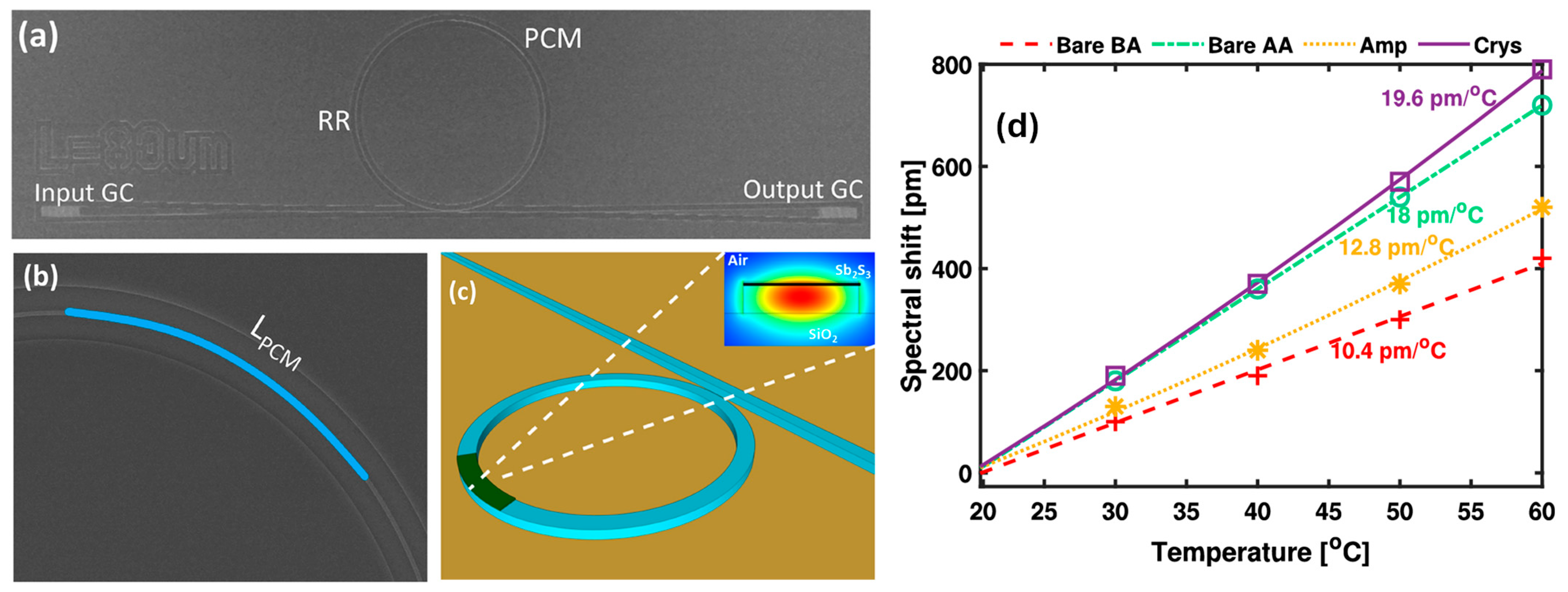
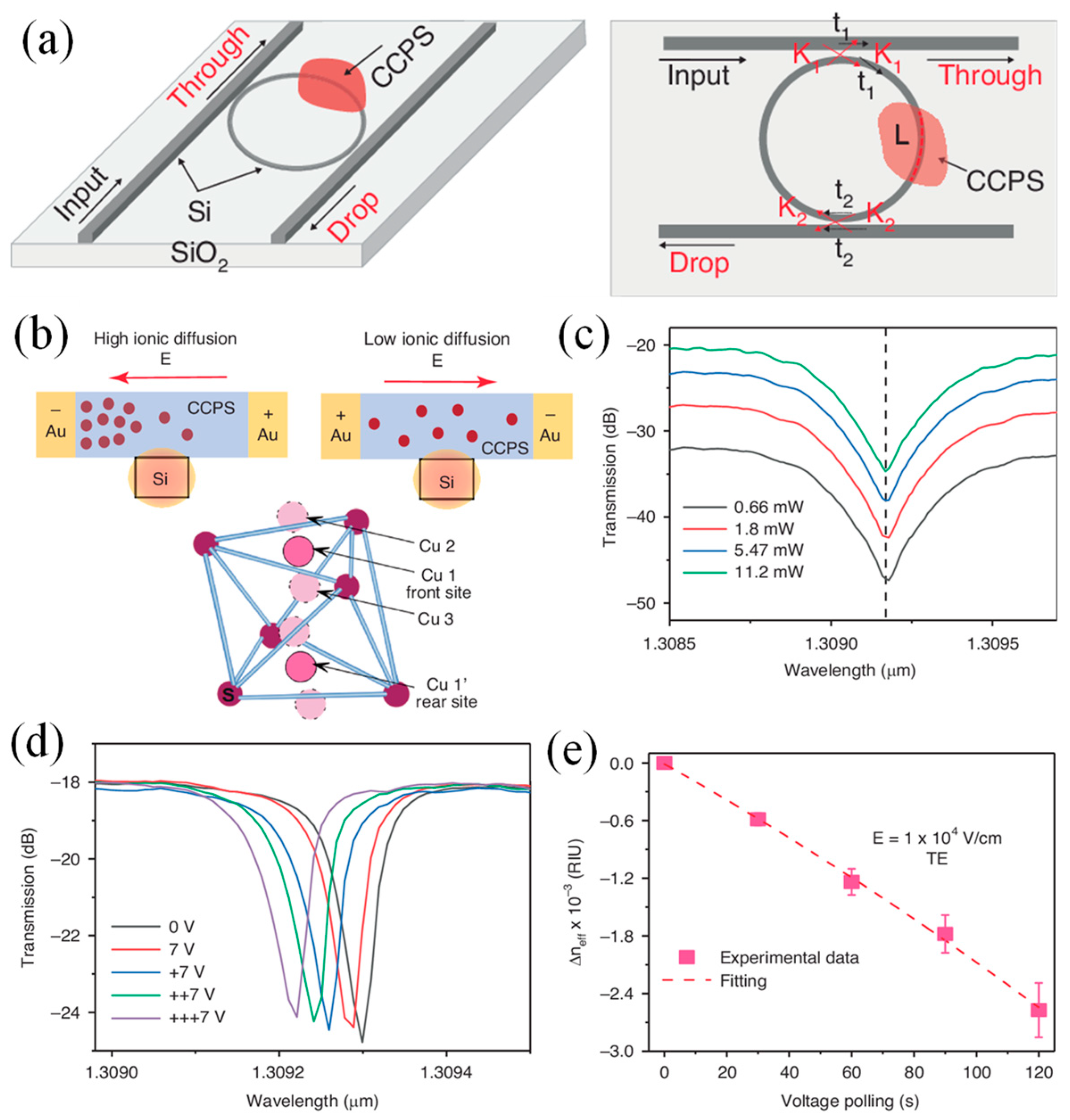
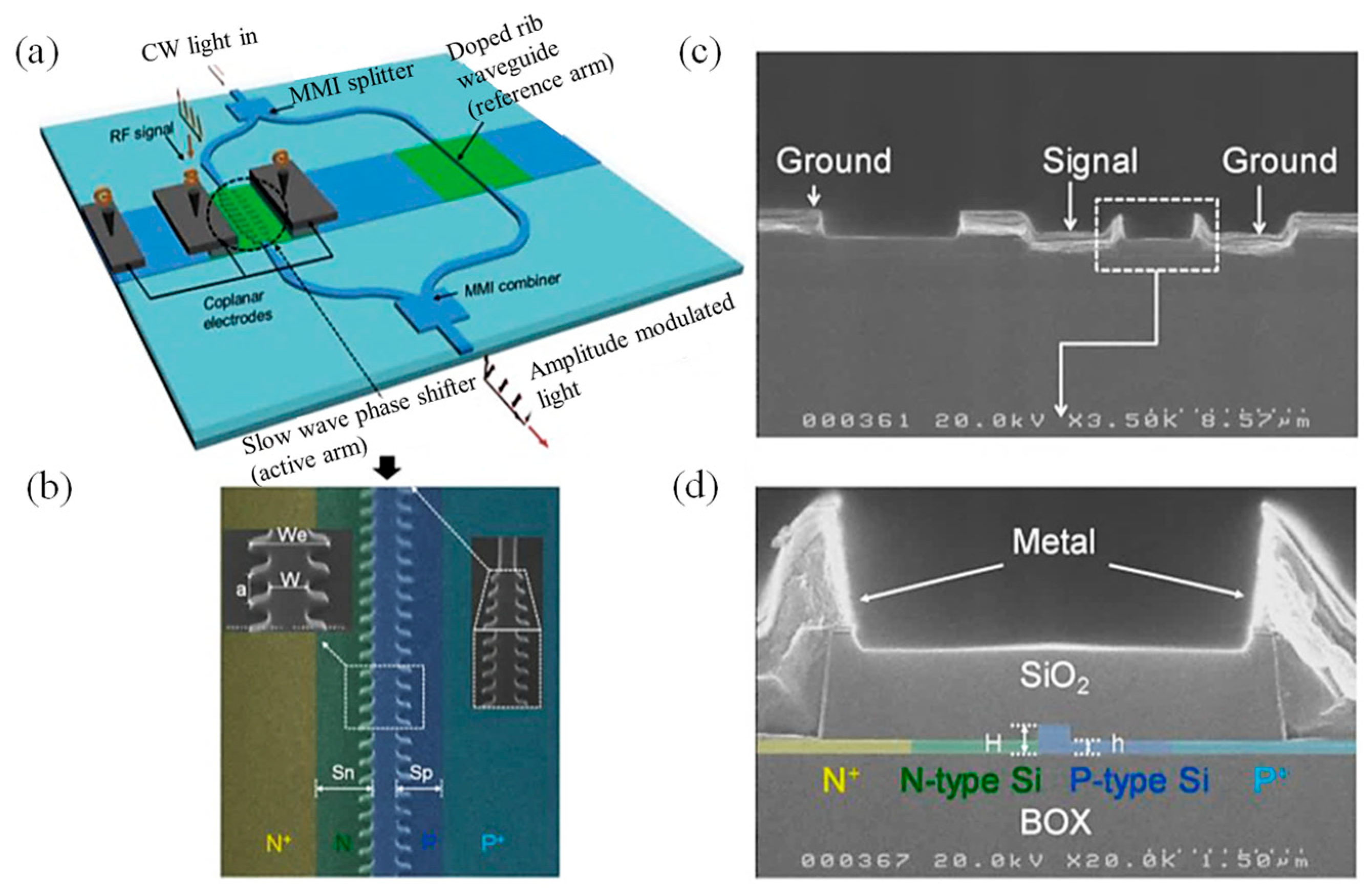
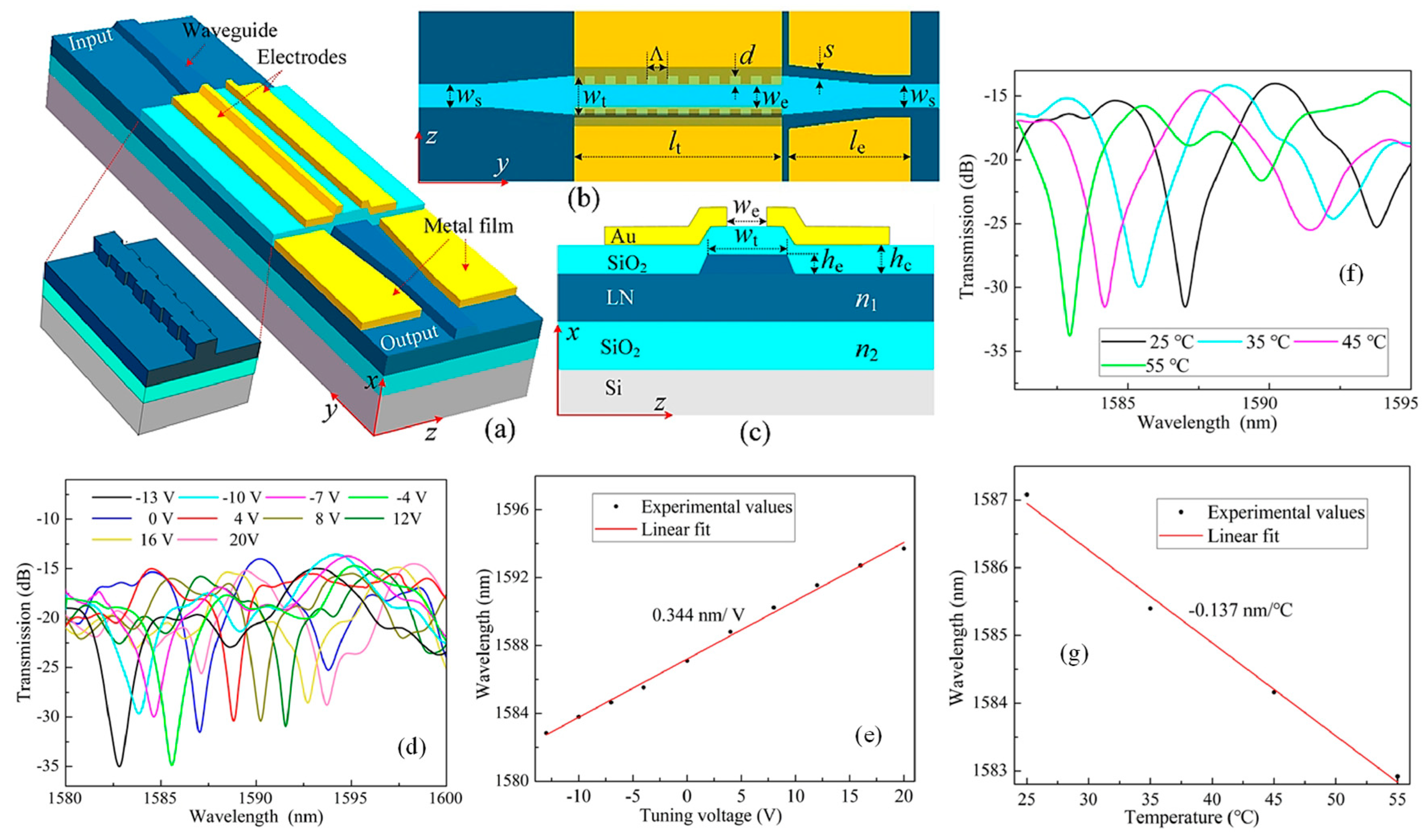
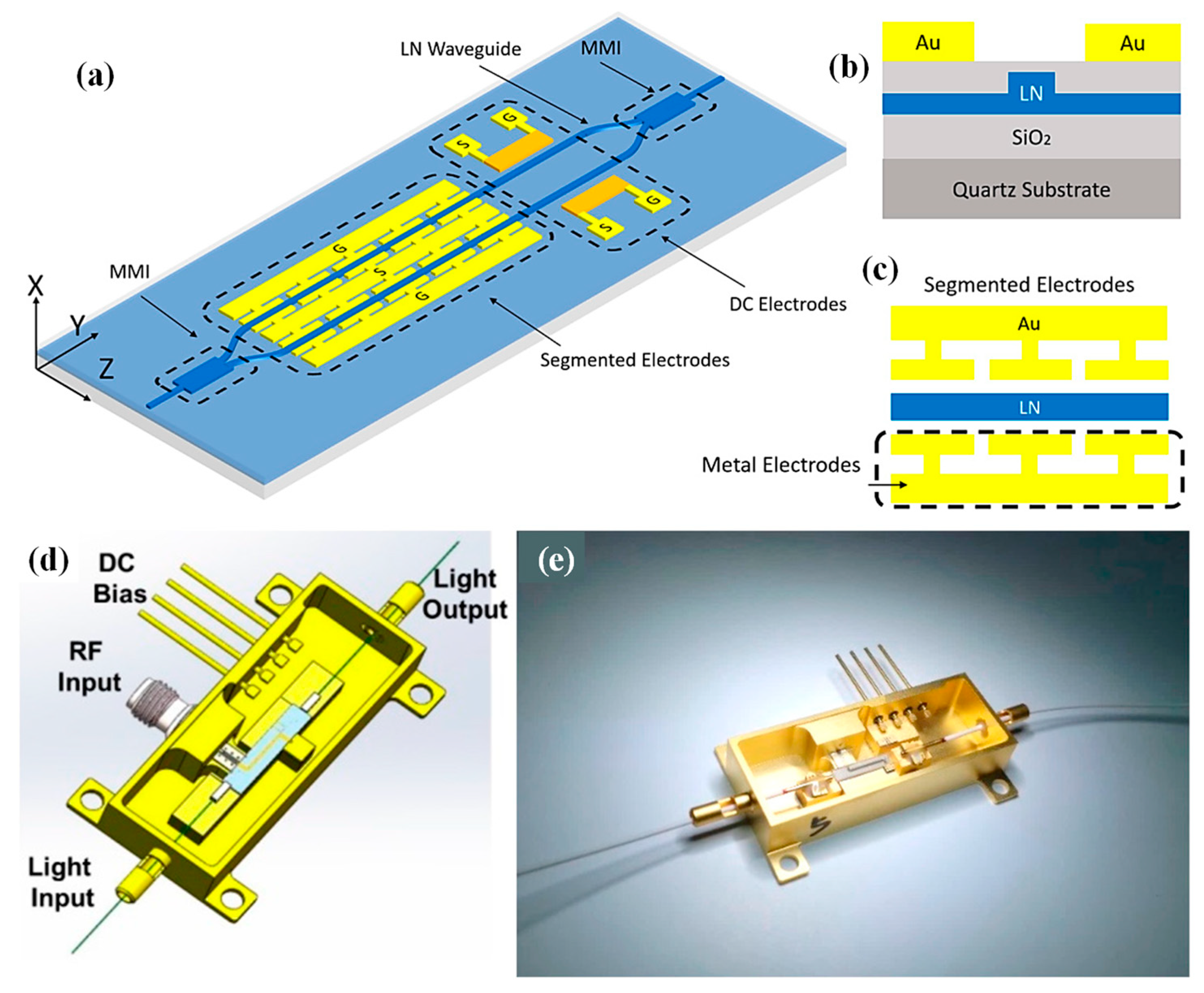
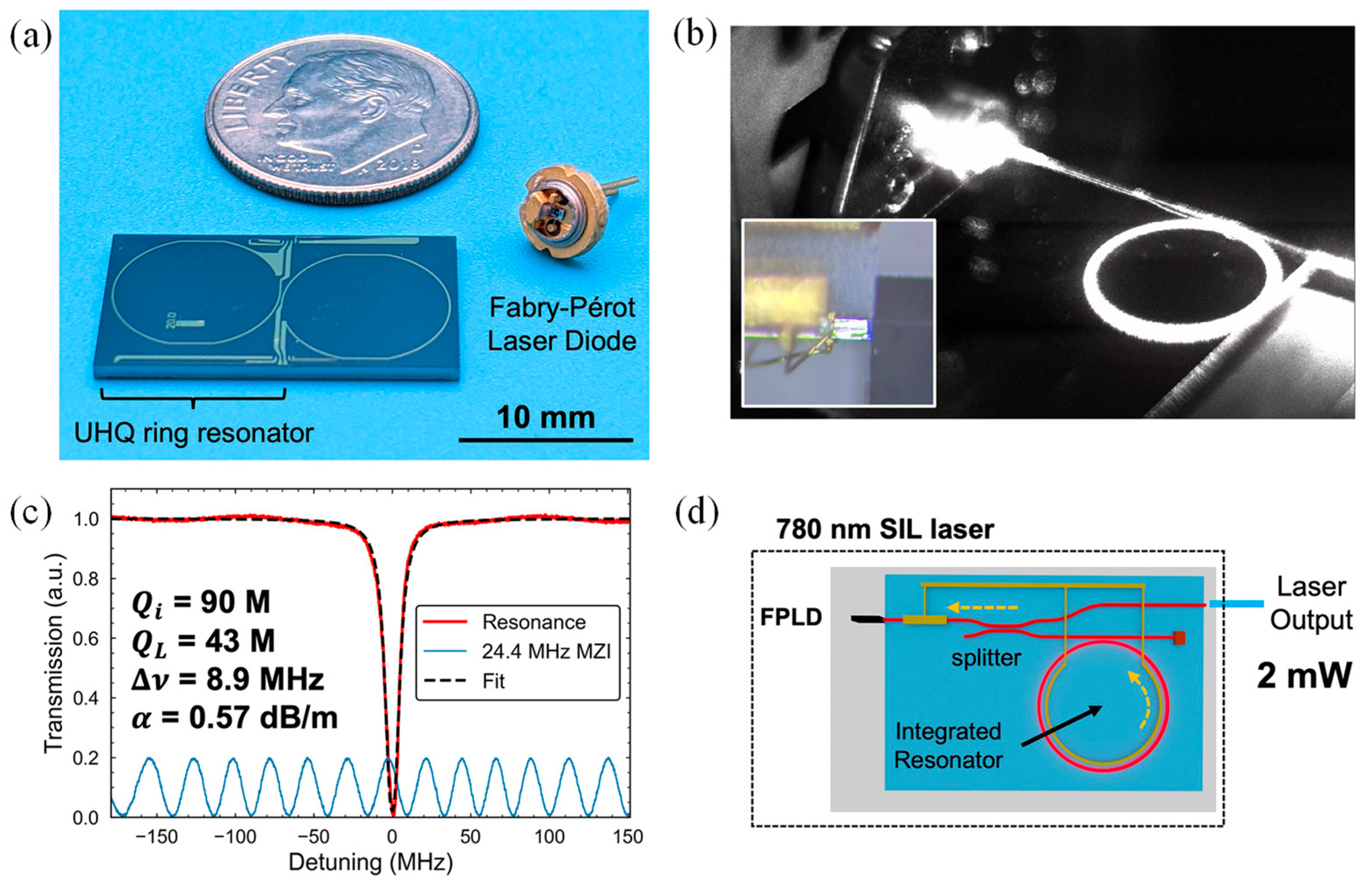
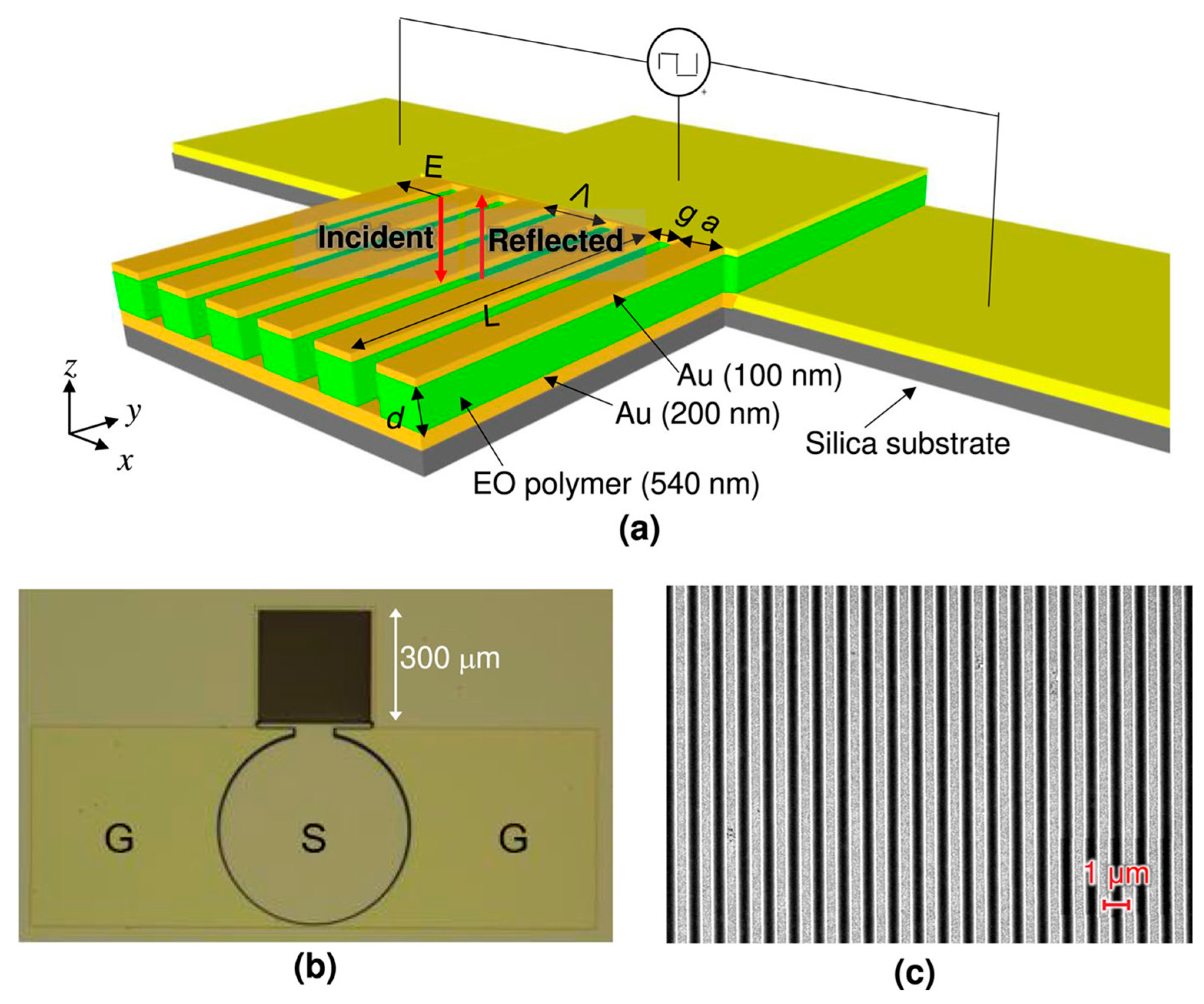
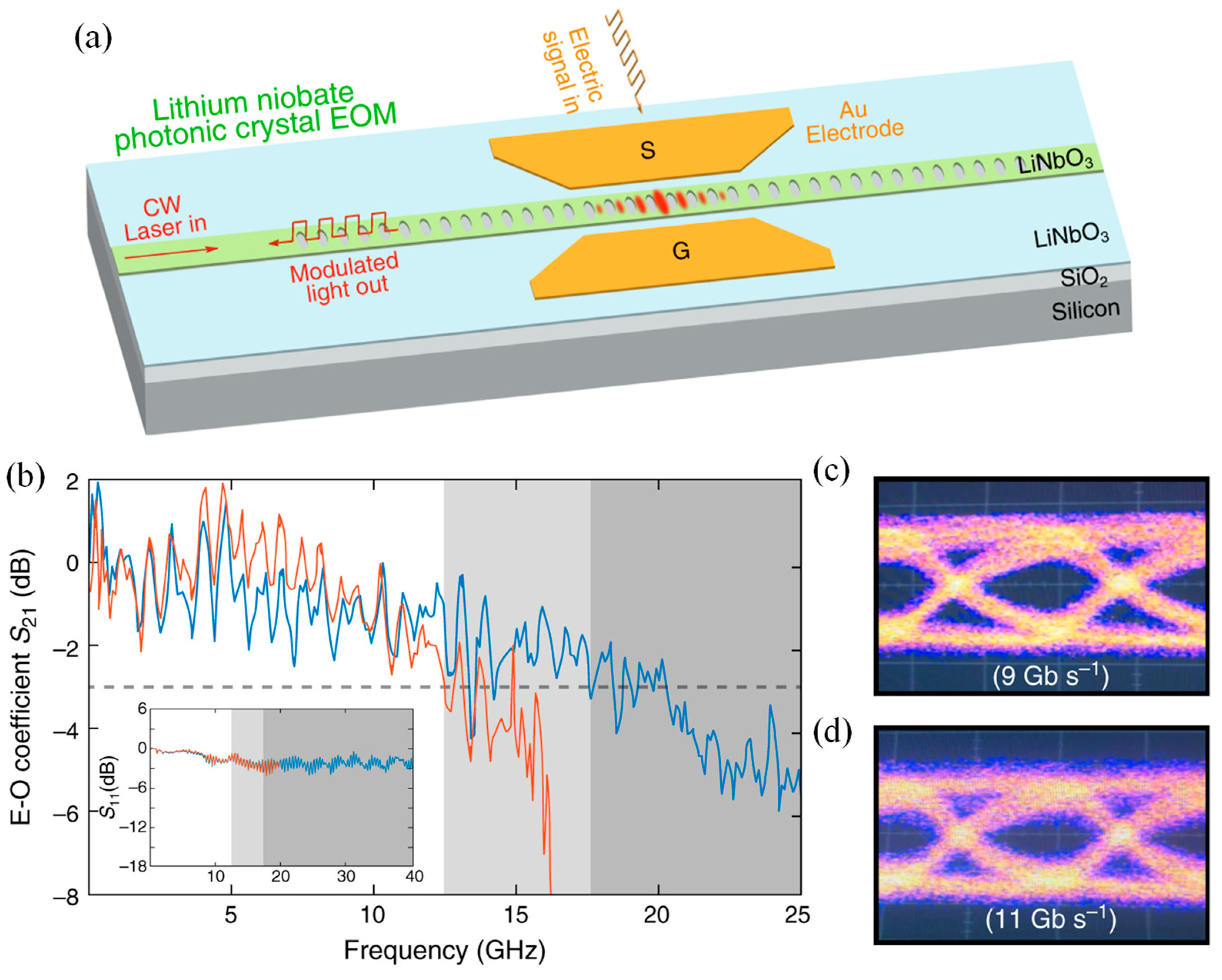
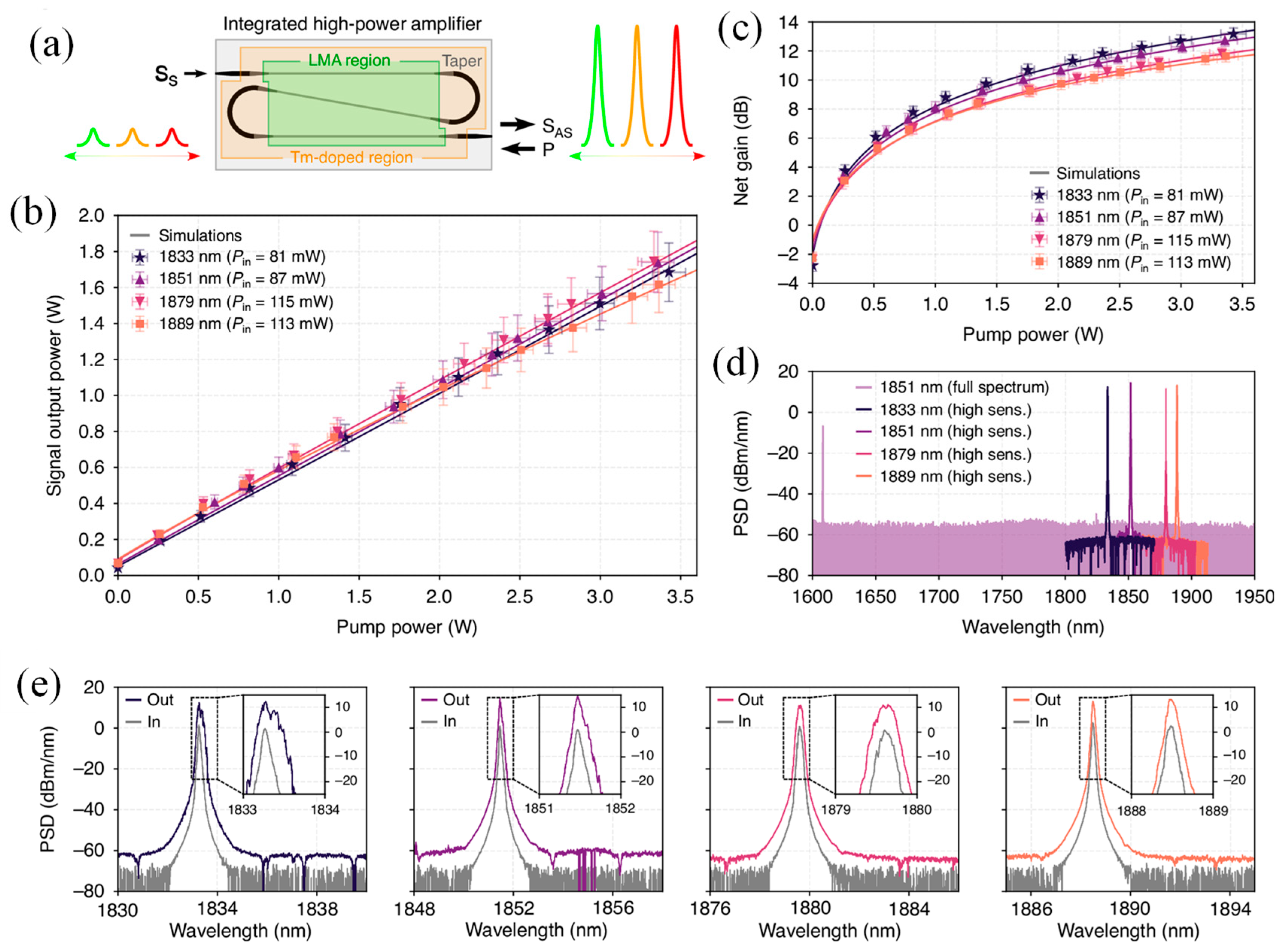
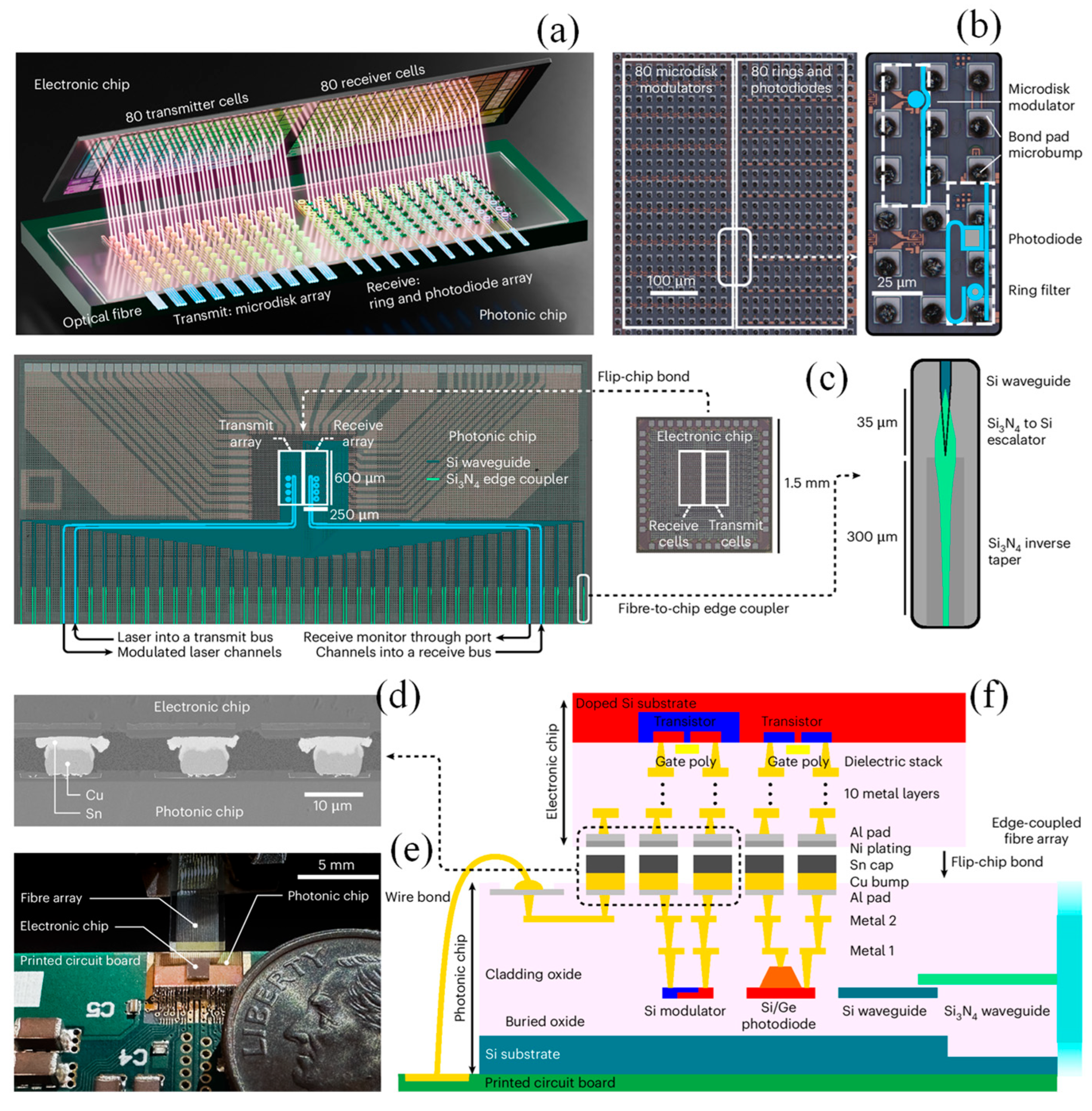
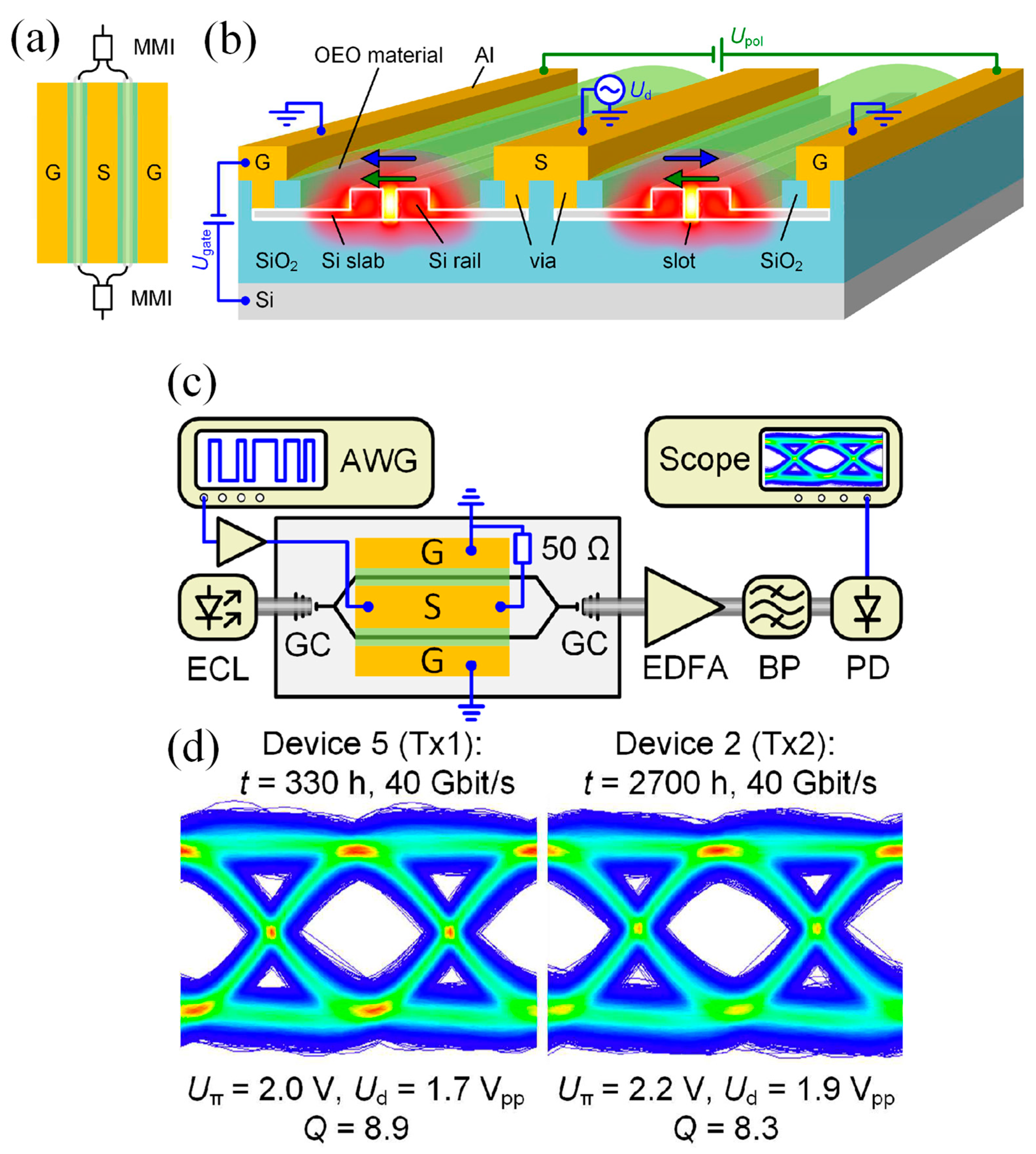
Disclaimer/Publisher’s Note: The statements, opinions and data contained in all publications are solely those of the individual author(s) and contributor(s) and not of MDPI and/or the editor(s). MDPI and/or the editor(s) disclaim responsibility for any injury to people or property resulting from any ideas, methods, instructions or products referred to in the content. |
© 2025 by the author. Licensee MDPI, Basel, Switzerland. This article is an open access article distributed under the terms and conditions of the Creative Commons Attribution (CC BY) license (https://creativecommons.org/licenses/by/4.0/).
Share and Cite
Butt, M.A. Emerging Trends in Thermo-Optic and Electro-Optic Materials for Tunable Photonic Devices. Materials 2025, 18, 2782. https://doi.org/10.3390/ma18122782
Butt MA. Emerging Trends in Thermo-Optic and Electro-Optic Materials for Tunable Photonic Devices. Materials. 2025; 18(12):2782. https://doi.org/10.3390/ma18122782
Chicago/Turabian StyleButt, Muhammad A. 2025. "Emerging Trends in Thermo-Optic and Electro-Optic Materials for Tunable Photonic Devices" Materials 18, no. 12: 2782. https://doi.org/10.3390/ma18122782
APA StyleButt, M. A. (2025). Emerging Trends in Thermo-Optic and Electro-Optic Materials for Tunable Photonic Devices. Materials, 18(12), 2782. https://doi.org/10.3390/ma18122782






